What Animals Can Be Found In The Tropical Rainforest
Rainforest Animals
Rainforest animals include mammals such as sloths, tapirs, jaguars, tigers, howler monkeys, spider monkeys and orangutans; reptiles such as caimans and the light-green anaconda; amphibians such as poisonous substance dart frogs and the ruddy-eyed tree frog; and birds such as toucans, macaws and the harpy eagle.
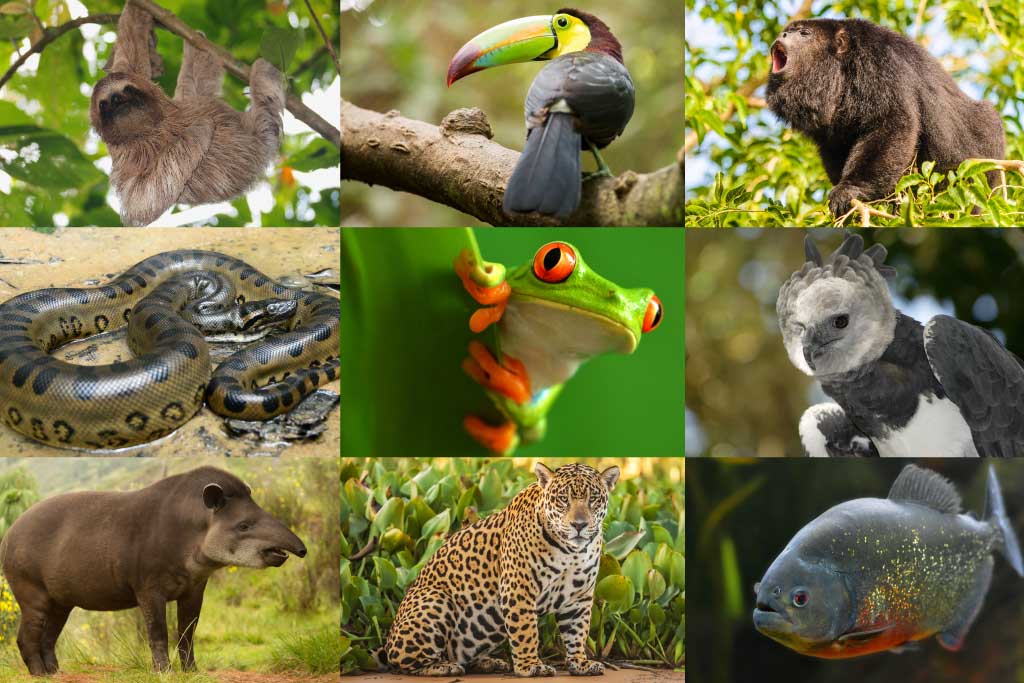
On this page is an alphabetical listing of rainforest animals with pictures and facts.
- Yous can use the Rainforest Animals Alphabetize, below, to find information on a specific rainforest species.
- Find out how much you lot know about rainforest animals by downloading the free printable worksheet for use with this page (simply download and print: no sign-up necessary!)
- Become a rainforest expert with our Rainforest Workbooks (a fun home or classroom activity!)
Introduction
Despite covering only between half dozen and seven% of the globe'south land surface, rainforests are home to more one-half of all the world's animal and found species.
In addition to the vast number of known rainforest animals, biologists approximate that there are millions of species living in rainforests that are still to exist discovered!
On this page you'll find information on a broad range of rainforest animals. What's your favorite? Have y'all always seen any of the animals on this page? Permit the states know in the comments section at the bottom of the page!
Rainforest Animals List: Index
| Rainforest Amphibians | Rainforest Birds | Rainforest Fish |
| Poison Dart Frog Red Eyed Tree Frog White-Lipped Treefrog | Harpy Eagle Hoatzin King Vulture Lovely Fairywren Macaw Rainforest Scops Owl Toucan | Candiru Electric Eel Piranha South American Lungfish |
| Rainforest Insects | Rainforest Mammals | Rainforest Reptiles |
| Blueish Morpho Butterfly Giraffe Weevil Goliath Beetle Leafcutter Ant Ruddy Imported Fire Ant | Anteater Aye-Aye Binturong Capybara Civet Coati Howler Monkey Jaguar Lemur Leopard Ocelot Orangutan Sloth Spider Monkey Tapir Tarsier Tiger Vampire Bat | Arrau Turtle Boa Constrictor Caiman Green Anaconda Greenish Iguana |
| Other Rainforest Animals | ||
| Amazonian Giant Centipede Goliath Birdeater |
You tin find out more well-nigh the animals listed beneath by clicking on the pictures or on the links provided.
Other rainforest animate being pages on ActiveWild:
- Rainforest Mammals List with Pictures & Facts
- Rainforest Reptiles List with Pictures & Facts
- Rainforest Insects Listing with Pictures & Facts
- Rainforest Monkeys Listing with Pictures & Facts
FREE Rainforest Animals Printable Worksheet – Test your noesis!
Click on the images or links beneath to view & download Gratis printable question sheets for employ with this page.
(You can observe more than free worksheets from Active Wild on this page: Free Printable Worksheets.)


Worksheet Download Links
- Rainforest Animals Question Sheet 1: View and download
- Rainforest Animals Question Canvass ii: View and download
The answers to the questions can be found either on this page or on pages linked to from this page.
These question sheets brand a great home or classroom activity, and tin exist used to encourage internet-based research, likewise equally to meliorate knowledge of the rainforest biome.
List Of Rainforest Animals
For individual species (i.e. tiger), we've included the animal'south scientific name and its IUCN conservation status (if assessed).
For groups of species (i.e. anteaters) nosotros've included the number of species in the grouping and the group'south name.
Amazonian Giant Centipede
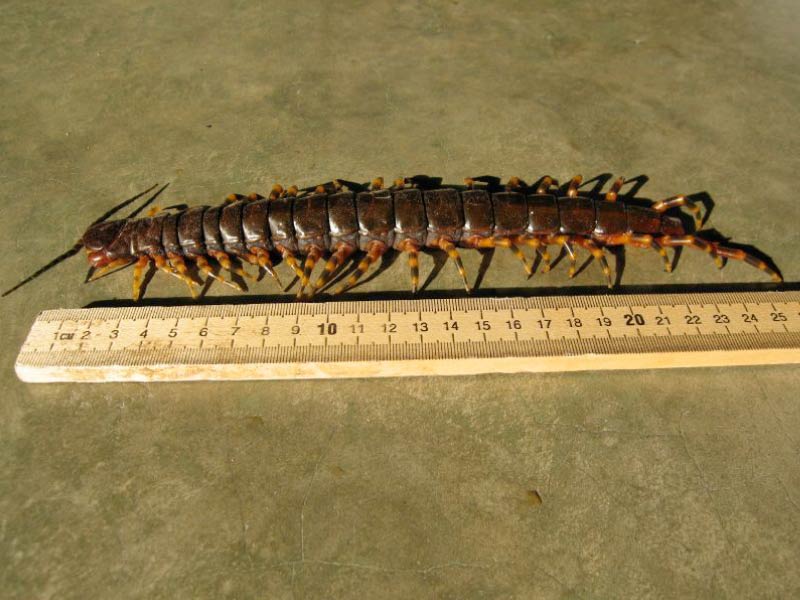
- Scientific name: Scolopendra gigantea
- Conservation status: Unassessed
- Where found: Southward America
Reaching lengths of upward to thirty cm (1 ft.), the Amazonian behemothic centipede is one of the world'southward largest centipedes. The species is plant in the Amazon Basin (the region surrounding the Amazon River) and other tropical parts of northern S America.
The Amazonian giant centipede is a voracious predator. It hunts insects, spiders (including tarantulas), lizards, frogs, snakes and even modest mammals. The centipede injects its prey with paralyzing venom. This venom is delivered via 'venom claws' located on the centipede'south first segment.
- You can find out more about centipedes on this page: Centipede Facts
Return to Alphabetize
Anteater
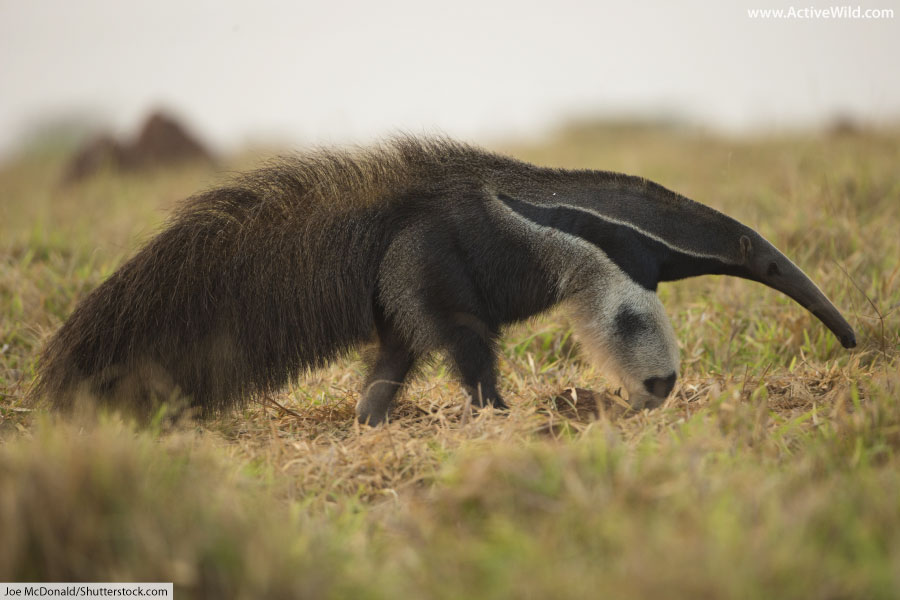
- Number of species: iv
- Suborder: Vermilingua
- Where found: Key & South America
Anteaters belong to a group of animals with the Latin name Vermilingua, which means 'worm tongue'. The name comes from the animals' long, sparse tongues, which are used to gather up large quantities of ants and termites.
In that location are four species of anteater: the giant anteater, silky anteater, southern tamandua and northern tamandua.
- Yous can observe more nearly anteaters on this page: Anteater Facts
- Find out more most the giant anteater on this folio: Giant Anteater Facts
Return to Index
Arrau Turtle
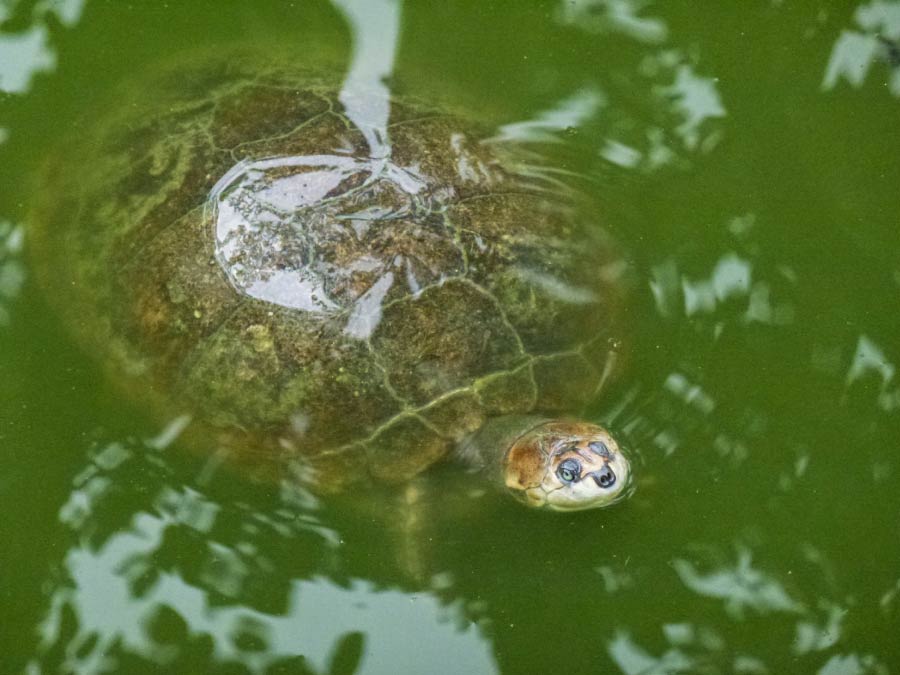
- Scientific proper name: Podocnemis expansa
- Conservation status: Lower Risk / Conservation Dependent
- Where institute: South America
The Arrau turtle is also known as the South American river turtle. Information technology is a big freshwater turtle found in rivers throughout much of northern South America. The species is present in both the Amazon and the Orinoco rivers.
Full-grown adults have carapace (shell) lengths of over one m (three.three ft.) and can weigh upwardly to 90 kg (200 lb.).
The Arrau turtle is the globe's largest species of side-necked turtle. Side-necked turtles (Pleurodira) tuck their heads into their shells with a sideways motion. (Members of the other master group of turtles, Cryptodira, draw their heads straight dorsum into their shells.)
Although the Arrau turtle's conservation status is currently 'Lower Risk', its population is thought to be declining speedily and there are some calls for the species to be considered 'Critically Endangered'.
Return to Index
Aye-yes
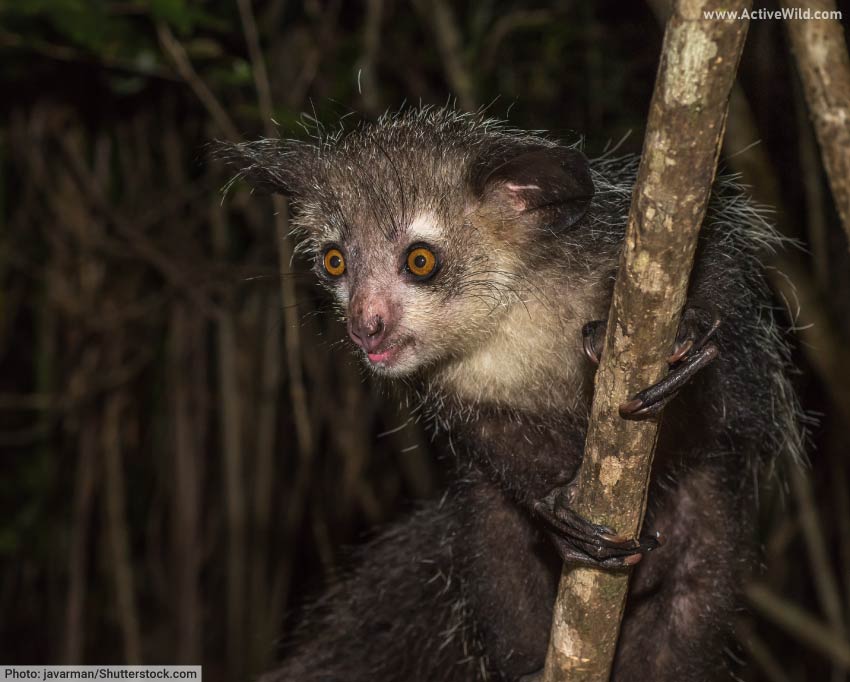
- Scientific proper noun: Daubentonia madagascariensis
- Conservation Status: Endangered
- Where found: Africa (Madagascar)
The yeah-aye is a species of lemur plant in the rainforests of Madagascar (an island country off the east coast of Africa). It is the earth's largest nocturnal primate.
(You can find out more about lemurs further down the page.)
The aye-yeah eats grubs (insect larvae), which it finds by tapping on trees with its fingers. By listening carefully to the noise produced past the tapping, it can tell if a grub is hidden under the bark.
The aye-aye's elongated heart fingers are specially adapted for hooking grubs out of holes.
- You can detect out more nigh aye-ayes on this page: Aye-aye Facts
Render to Index
Binturong
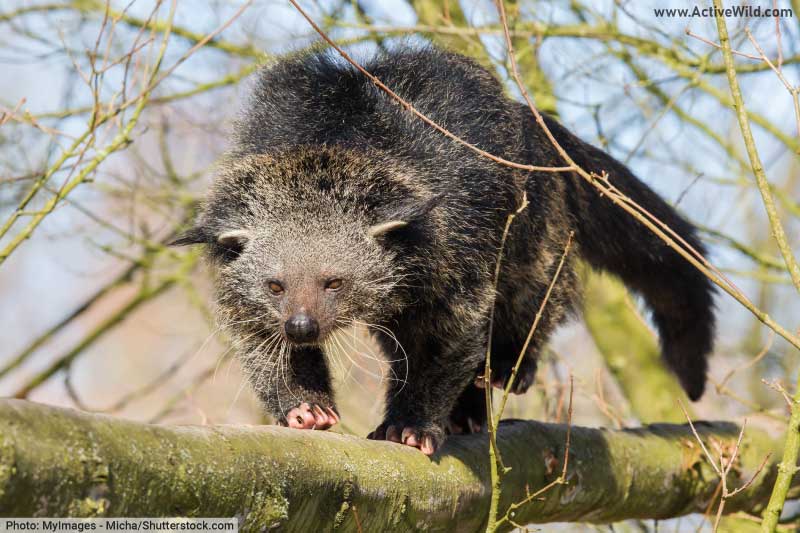
- Scientific name: Arctictis binturong
- Conservation Condition: Vulnerable
- Where found: Asia
Binturongs – otherwise known as 'bearcats' – are the largest members of the animal familyViverridae. (Members of this family are known every bit viverrids).
The binturong'southward long tail is 'prehensile' (i.e. it can concur onto things). A binturong uses its tail as an 'actress mitt' while climbing.
The binturong is the merely Old Globe mammal with a prehensile tail. ('Former Globe' is a collective term for the continents of Europe, Asia and Africa.)
Binturongs live in the forests of South and Southeast Asia.
- Y'all can find out more about the binturong on this page: Binturong Facts
Render to Alphabetize
Blueish Morpho Butterfly
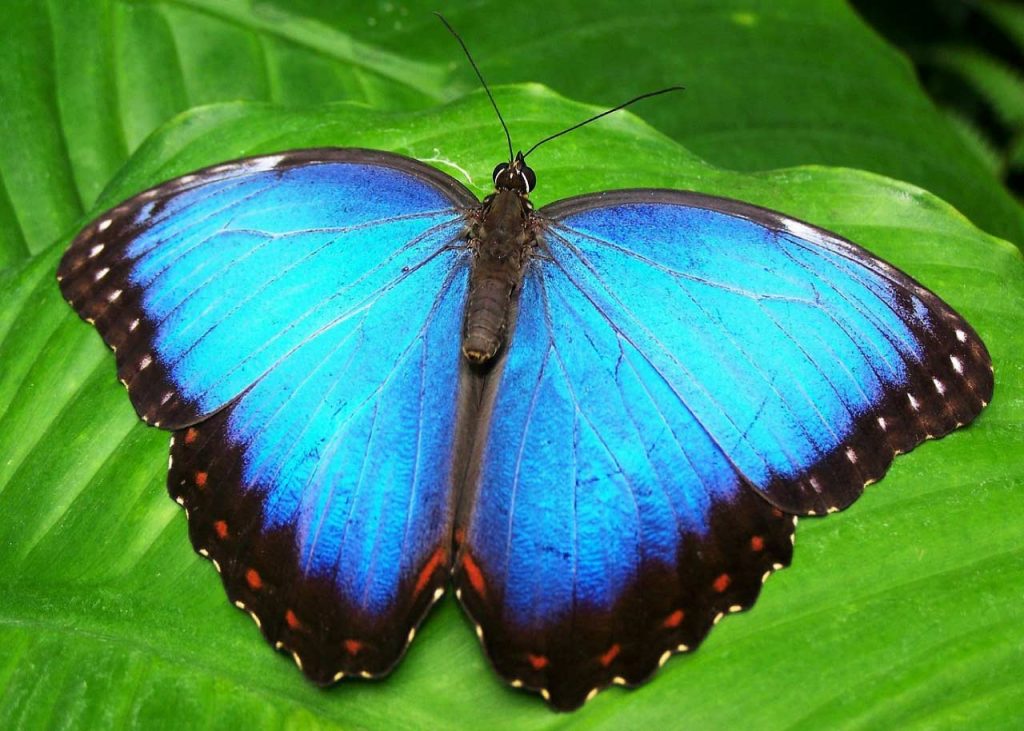
- Number of species: 6
- Genus: Morpho
- Where found: Key & Southward America
Blue morphos are brilliant bluish collywobbles. At that place is more than one species of blue morpho; the name is used for whatever blue butterfly in the genus morpho. (A genus is a group of closely related species.)
Bluish morphos feed (among other things) on rotting fruit, which they find on the floor of rainforests in South and Primal America.
Sometimes there are so many blue morphos flying over the rainforest canopy that pilots tin encounter the blue of their wings from the sky!
- Yous can find out more than about blue morpho butterflies on this page: Blue Morpho Butterfly Facts
Return to Index
Boa Constrictor
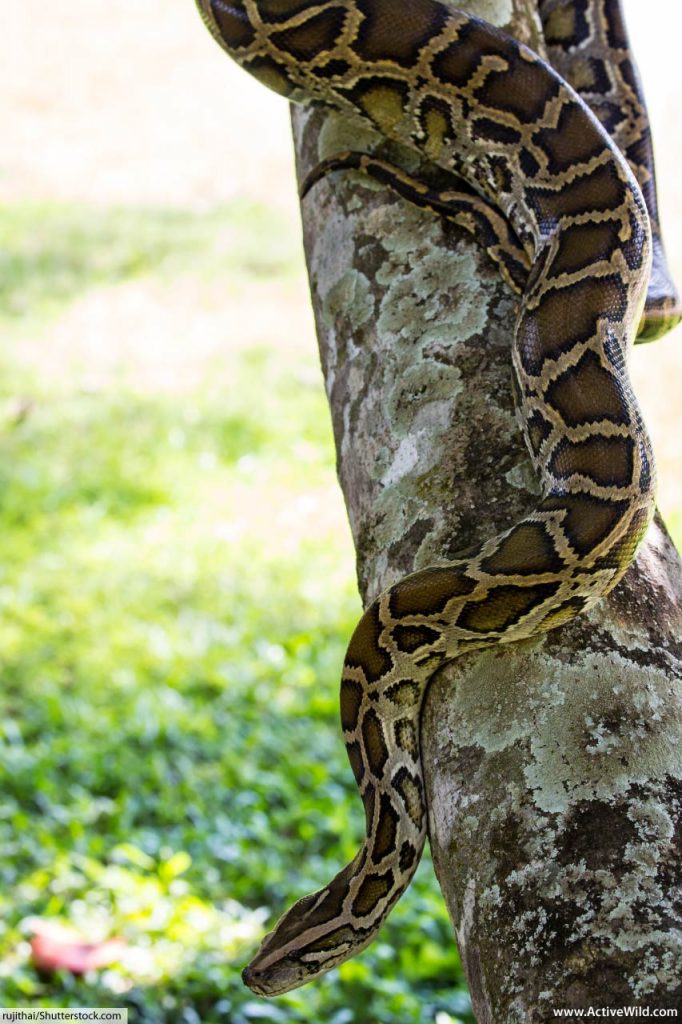
- Scientific name: Boa constrictor
- Conservation status: Currently Unassessed
- Where found: Fundamental & Due south America
The boa constrictor is a large rainforest snake. It ambushes its prey, then constricts (squeezes) it before swallowing it whole.
This fearsome reptile is found in Central and Due south American rainforests.
The boa constrictor is a member of the family Boidae, a group of large, non-venomous snakes that likewise contains the light-green anaconda (see further down the page).
The boa constrictor is one of the few animals commonly known by their scientific names!
- You tin can find out more than about the boa constrictor on this page Boa constrictor facts
Return to Index
Caiman

- Number of species: vi
- Family: Alligatoridae; subfamilyCaimaninae
- Where found: Central & Southward America
Caimans are predatory reptiles that alive in the rivers and lakes of Key and South American rain forests (and other habitats). There are 6 species of caiman.
The spectacled caiman (Caiman crocodilus) is one of the nearly common species of caiman. It gets its name from the bony ridge on its nose, which makes the reptile appear to be wearing spectacles.
The largest caiman is the black caiman (Melanosuchus niger), which grows to lengths in backlog of 5 m (16 ft).
Together with crocodiles, alligators and gharials, caimans course a grouping of animals known equally 'Crocodilians'.
- Detect out more about caimans on this folio: Caiman Facts & Information.
- You lot tin can find out more than nigh the spectacled caiman on this page: Spectacled Caiman Facts
Return to Alphabetize
Candiru

- Scientific proper name: Vandellia cirrhosa
- Conservation status: Unassessed
- Where constitute: South America
The candiru is a small fish found in the Amazon River and several other South American rivers and their tributaries. Information technology has a long, thin, translucent trunk. Small spines are nowadays on its gill covers.
These rainforest fish feed on the claret of larger fish by attaching themselves to their gills of their victims. It is even rumored that the candiru tin can enter a human body. Withal, this is both unproven and unlikely.
Render to Index
Capybara
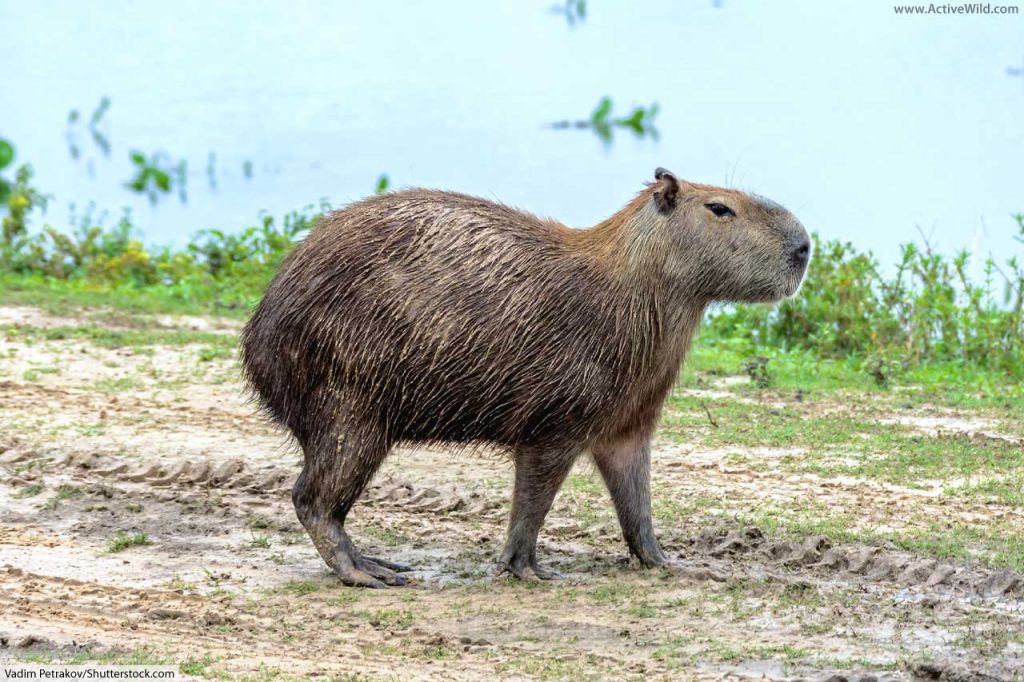
- Scientific proper noun: Hydrochoerus hydrochaeris
- Conservation status: To the lowest degree Concern
- Where establish: Central & South America
The capybara is the world'southward largest rodent. Information technology lives Southward and Central American forests.
The capybara has several adaptations for a semi-aquatic lifestyle. and is always constitute living shut to water. It can remain submerged for up to 5 minutes; a useful skill for an animal whose predators include jaguars and ocelots!
- You tin read more than almost capybaras on this folio: Capybara Facts.
Return to Index
Civet
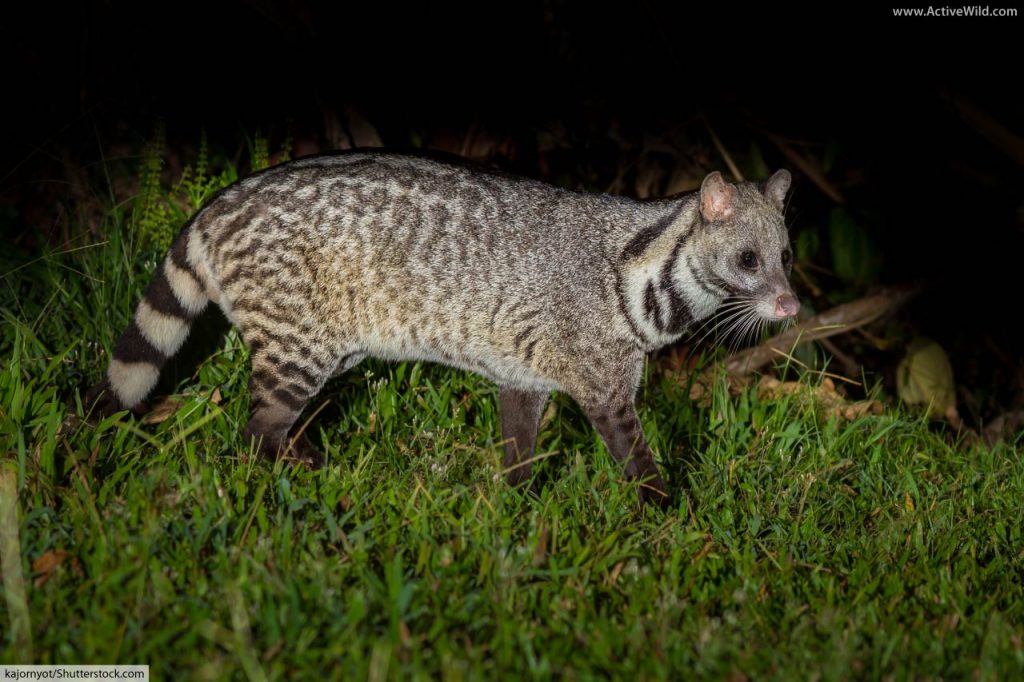
- Number of species: 12+
- Family: Viverridae
- Where found: Asia & Africa
Civets are cat-like mammals establish in rainforests in Asia and Africa. They produce a strong-smelling substance that is used to make perfume (although most perfume manufacturers are at present switching to synthetic alternatives).
Well-nigh civets are members of the family Viverridae (the binturong also belongs to this family). The African palm civet, a civet establish in African rainforests, is the only species in the family Nandiniidae.
Civets are mammals in the group Carnivora. This group is split into two branches; Feliforma (the cat-like carnivorans) and Caniformia (the dog-similar carnivorans). Civits, forth with animals such every bit cats and hyenas, are placed in Feliforma.
Return to Index
Coati
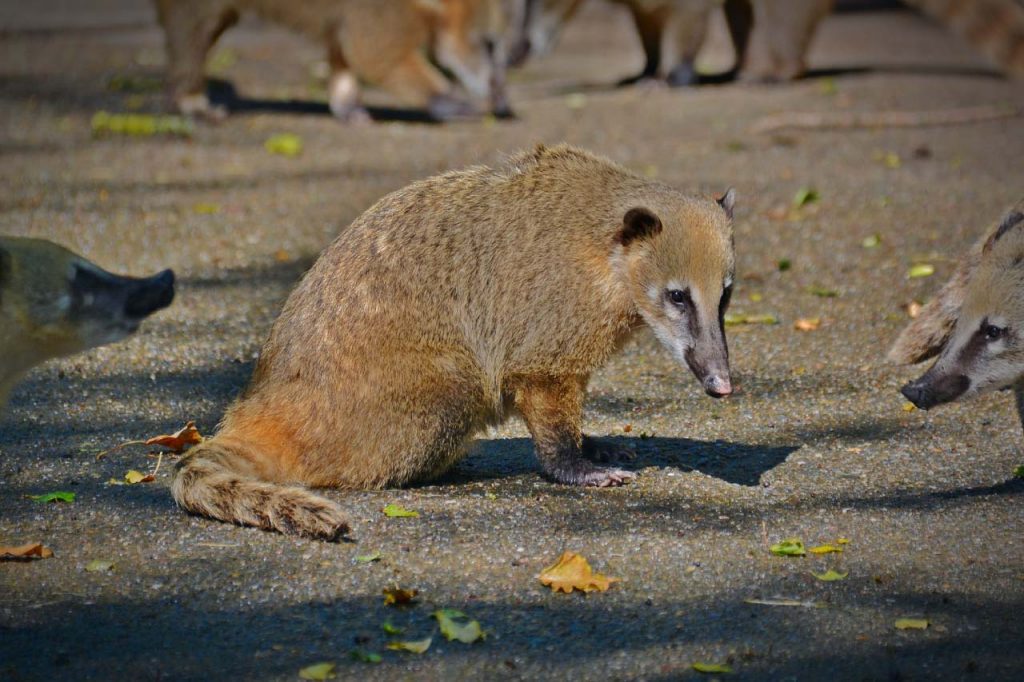
- Number of species: 4
- Genera: Nasua / Nasuella
- Where establish: North & Southward America
Coatis are also known every bit 'coatimundis'. These cat-sized cannibal mammals are members of the raccoon family, Procyonidae.
Coatis forage on the wood floor by mean solar day. They discover food among the leaf litter using their acute sense of smell. During the night they rest in the rainforest awning.
Coatis are found in Southward America and in southern Northward America.
- Yous tin can find out more about the South American coati on this page: Due south American Coati Facts
Render to Index
Electric Eel
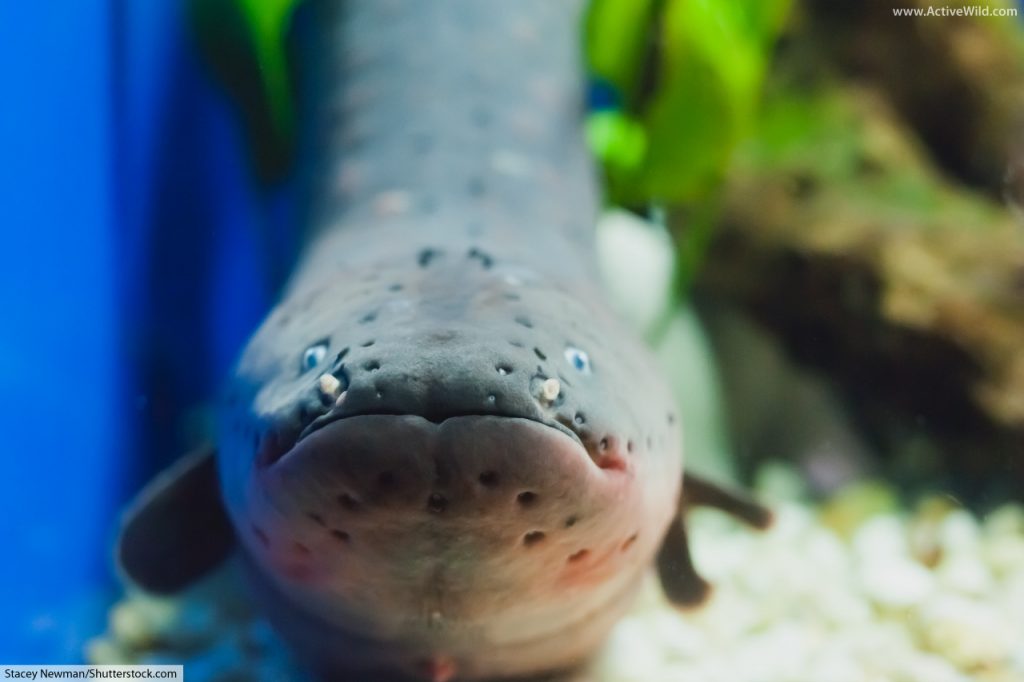
- Scientific proper name: Electrophorus electricus
- Conservation condition: Least Concern
- Where found: South America
Despite its name and eel-like appearance, the electric eel is a knifefish rather than a true eel. This long, thin fish has a fin running about the whole length of the underside of its torso. Past moving this fin with a moving ridge-similar motion the electric eel is able to swim both forwards and backwards.
Like other knifefish, the electrical eel is able to produce electrical fields that assist it navigate in murky water. The electric eel has profoundly developed this ability and is able to produce voltages potent enough both to stun prey and deter predators. A shock from an electric eel can fifty-fifty exist life-threatening to humans!
- You can find out more most this animate being on this page: Electric Eel Facts
Render to Index
Giraffe Weevil
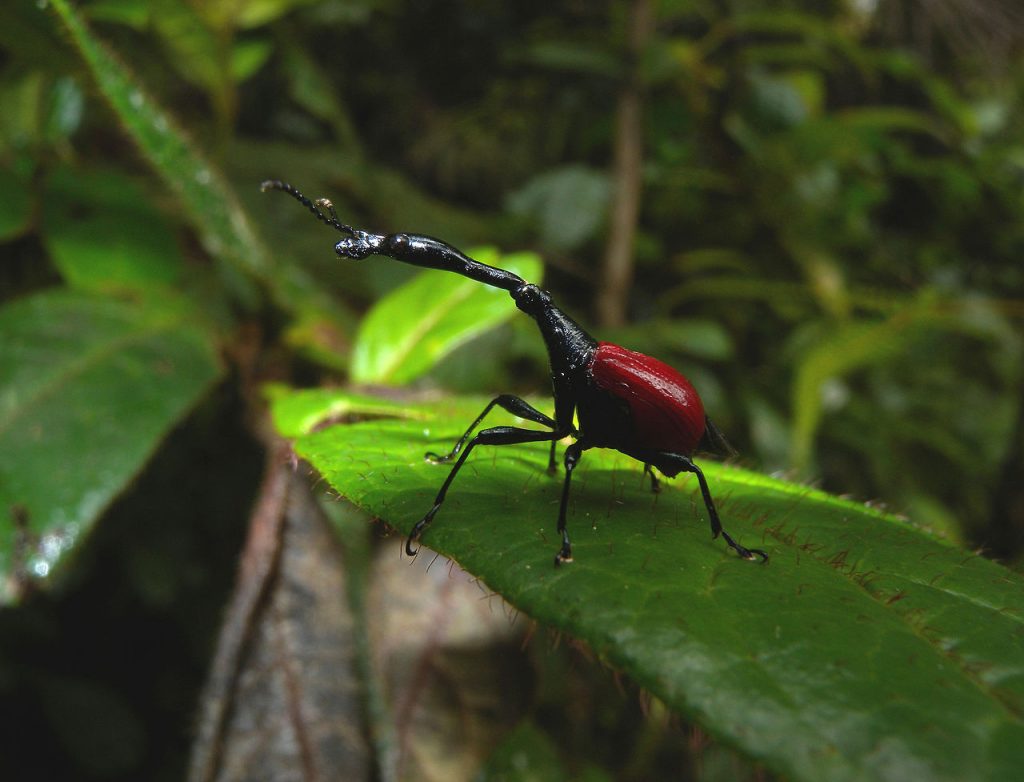
- Scientific name: Trachelophorus giraffa
- Conservation condition: Unassessed
- Where found: Africa (Republic of madagascar)
This strange-looking rainforest problems is found in the island country of Madagascar. The giraffe weevil's proper noun comes from the species' elongated neck. This is an adaptation for fighting and nest-building.
The neck of the male is over twice equally long as that of the female, giving the insect a total trunk length of almost 1 in. (two.54 cm).
The female person makes a nest past rolling a leaf into a tube, in which she will lay a single egg.
Return to Index
Goliath Beetle
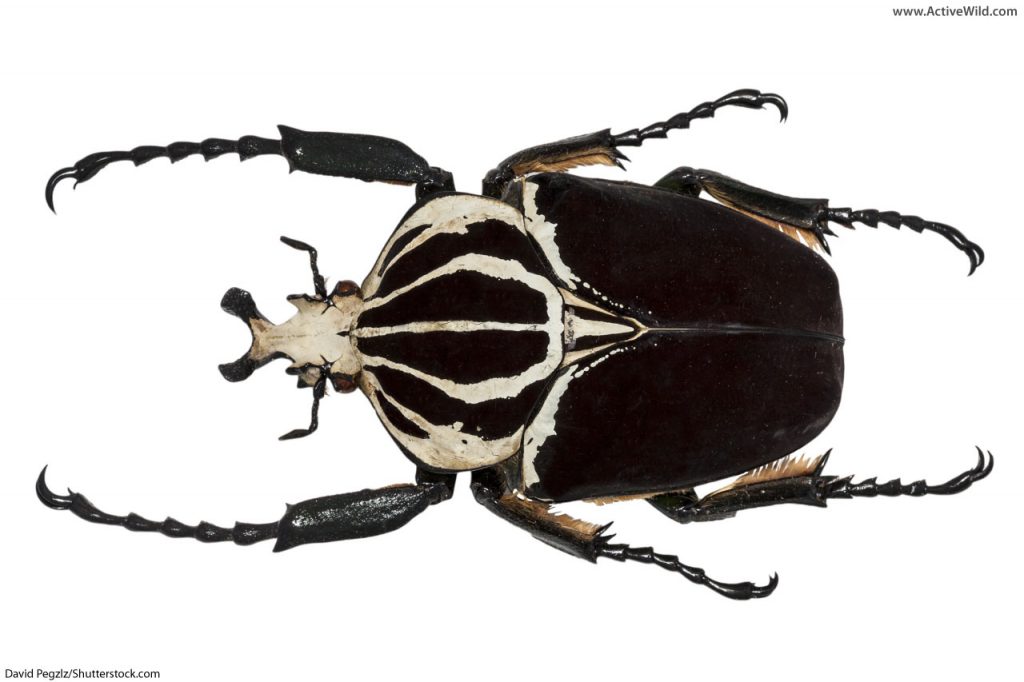
- Genus: Goliathus
- Number of Species: 5
- Where institute: Africa
The five species of goliath beetles are the earth's largest insects. In their adult form they are over 10 cm (3.93 in.) long. Their larvae weigh up to 100 grams (iii.5 oz.)
Despite their large size, Goliath beetles are still able to fly.
Goliath beetles are found in the tropical rainforests of Africa.
Render to Alphabetize
Goliath Birdeater
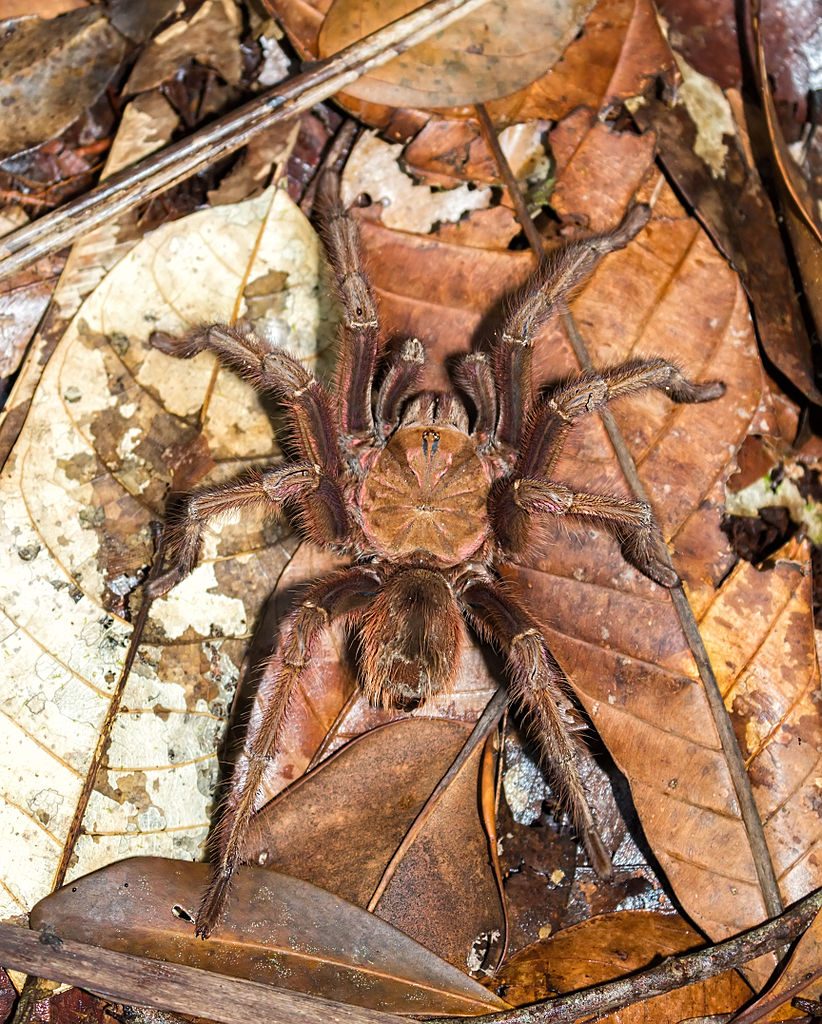
- Scientific proper noun: Theraphosa blondi
- Conservation status: Unassessed
- Where found: South America
The goliath birdeater is a member of the tarantula family Theraphosidae. This huge rainforest spider is the heaviest spider in the world (although its leg-span, at xi inches (28 cm) is only the second largest, after the giant huntsman spider). Its body reaches a length of upward to 4.75 in. (12 cm).
The Goliath birdeater lives deep in the rainforests of northern South America, including the Amazon rainforest. Information technology hunts at nighttime, preying on a variety of large invertebrates and small vertebrates, including lizards and frogs. Despite its name, the species simply occasionally eats birds.
Return to Alphabetize
Greenish Anaconda
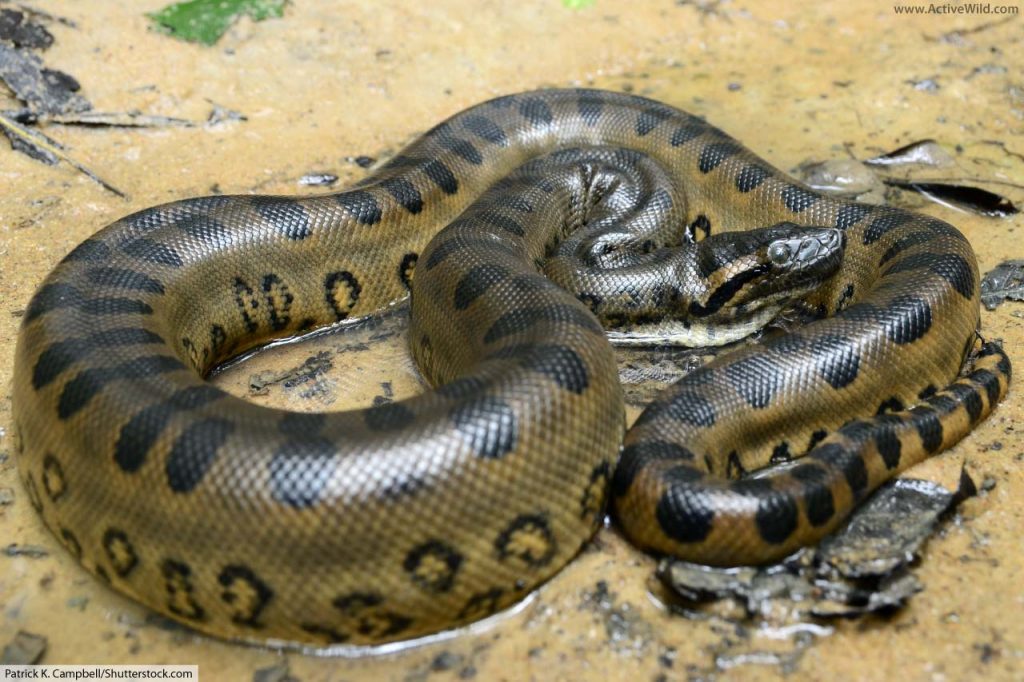
- Scientific proper noun: Eunectes murinus
- Conservation status: To the lowest degree Concern
- Where found: South America
The greenish anaconda is the world'due south heaviest species of snake, but non the longest (that's the reticulated python). Still, a green anaconda can even so grow to over 16.4 ft. / 5 metres in length!
This huge rainforest snake is an excellent swimmer, and is found in the lakes and rivers of the Amazon Rainforest.
Like all members of the family unit Boidae, the greenish anaconda is non-venomous. Instead, it relies on its squeezing ability to subdue its casualty.
- You can find out more about the green anaconda on this page: Green Anaconda Facts
Return to Index
Green Iguana
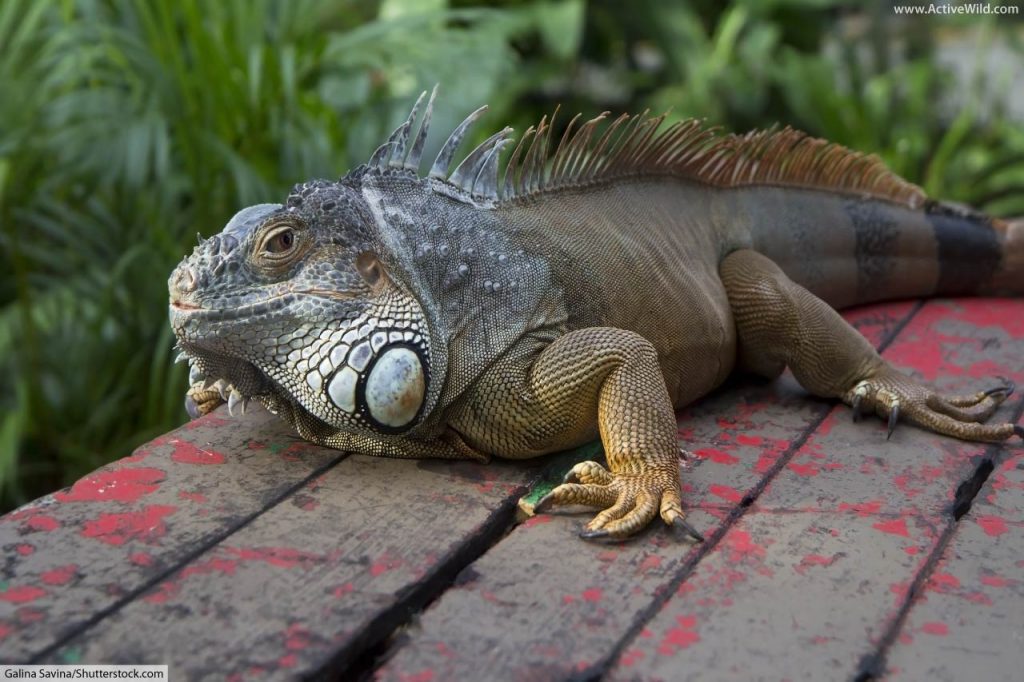
- Scientific name: Iguana iguana
- Conservation status: Least Business concern
- Where establish: Primal & South America
The greenish iguana is a big lizard that lives in the forests of Key and S America. Although this rainforest reptile looks fierce, it mainly eats plants.
The species is arboreal (tree-dwelling). It is often found most water, and is an first-class swimmer.
The closely-related Lesser Antillean iguana, a species establish in the rainforests of the Lesser Antilles islands in the Caribbean, is critically endangered .
- You can detect out more than about iguanas on this page: Iguana Facts
Return to Index
Harpy Eagle
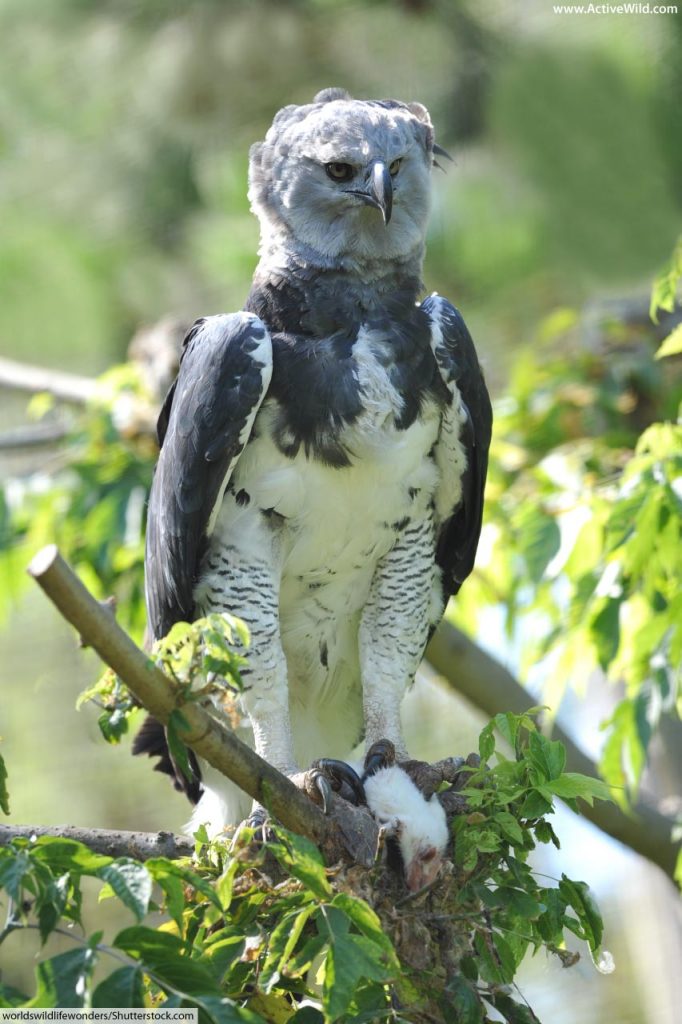
- Scientific name: Harpia harpyja
- Conservation status: Near Threatened
- Where found: Central & Southward America
The harpy hawkeye is the largest bird of prey found in the rainforest.
Although it is 1 of the world's biggest eagles, it's wingspan is (relatively) small; this is an adaption for flight through the forest.
The harpy eagle is said to be the globe's near powerful bird of casualty. It is capable of plucking mid-sized mammals such every bit monkeys and sloths from out of trees.
- Y'all tin read more than virtually the harpy eagle on this page: Harpy Hawkeye Facts
Render to Alphabetize
Hoatzin

- Scientific proper name: Opisthocomus hoazin
- Conservation status: Least Concern
- Where found: South America
The hoatzin is a pheasant-shaped bird with a long torso, broad tail, and a spiky crest on its head.
The hoatzin is an unusual bird for several reasons. Juvenile hoatzins take a hook at the 'elbow' joint of each of their wings. The species nests above water, and if threatened, the juveniles driblet into the h2o. Using their claws, they are able to climb dorsum into the nest once the danger has passed.
The species also has an unusual manner of digesting its nutrient, which consists largely of green leaves. The food is broken down by bacteria in a special area in the bird'south ingather (the expandable storage surface area in a bird's pharynx), in a similar way to that in which cows digest grass.
The fermenting leaves in the hoatzin'southward crop give off an unpleasant olfactory property. Because of this, the species has the alternative proper noun of 'stinkbird'.
Return to Alphabetize
Howler Monkey
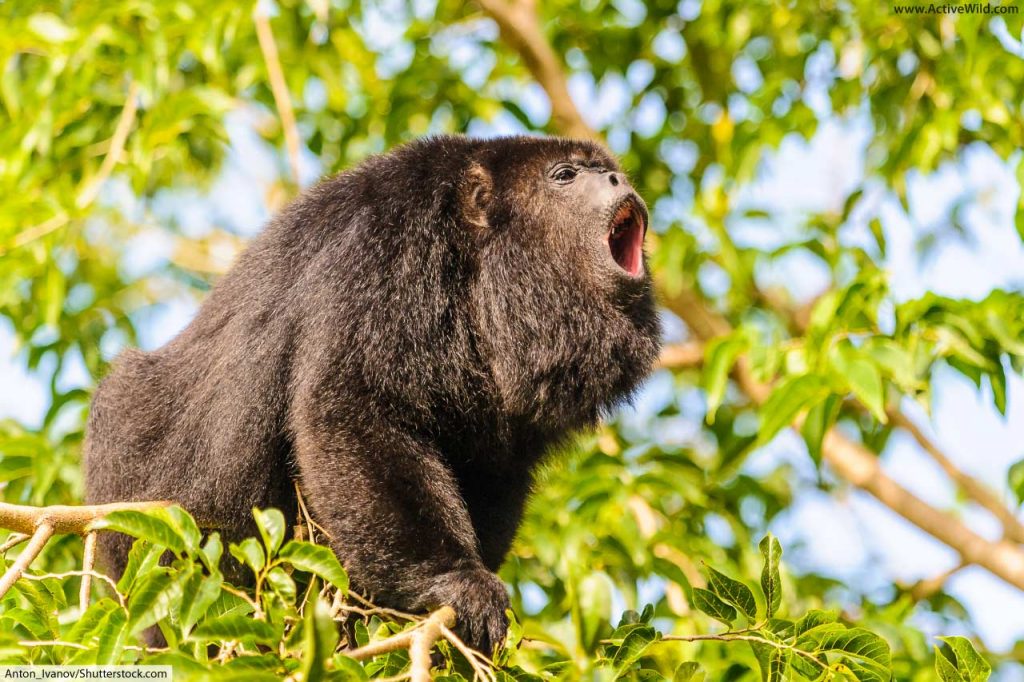
- Number of species: fifteen
- Family unit: Atelidae
- Where institute: Central & Southward America
All fifteen species of howler monkey live in the rainforests of South and Key America. Howler monkeys live in groups known every bit 'troops'. There tin can be from 6 to fifteen howler monkeys in a troop.
A howler monkey's cry can be heard through iii miles of rainforest. The monkeys use their loud voices to allow rival troops know where they are (this manner they don't really have to fight to go on their territories).
Despite the loud calls, some people keep howler monkeys as pets!
- You tin find out more virtually howler monkeys on this page: Howler Monkey Facts
Return to Alphabetize
Jaguar
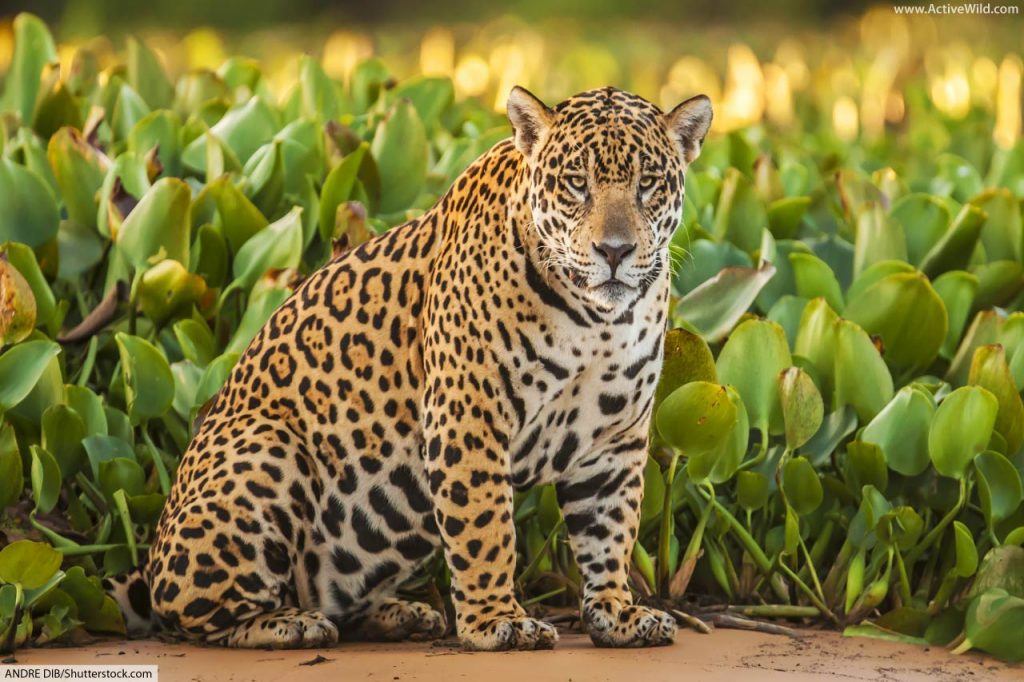
- Scientific proper noun: Panthera onca
- Conservation status: About Threatened
- Where found: Northward & South America
Jaguars are the globe's third-largest cat species — merely tigers and lions are bigger. These big cats alive in South American rain forests, where they are apex predators (i.due east. top of the nutrient chain).
Jaguars have extremely powerful jaws and are excellent swimmers – not fifty-fifty caimans are safe from these fearsome carnivores!
- You can detect out more than about this rainforest predator on this page: Jaguar Facts.
Return to Index
King Vulture
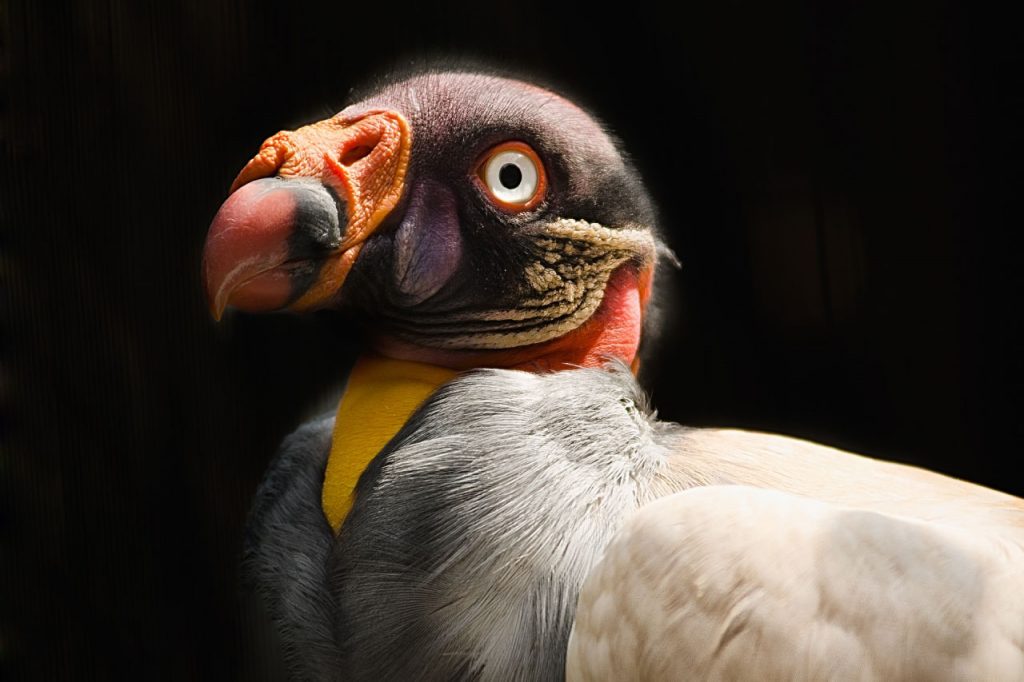
- Scientific name: Sarcoramphus papa
- Conservation status: Least Concern
- Where establish: Cardinal and South America
The rex vulture is a large bird that lives in the rainforests of Key and South America. It has black and white plumage and a strikingly-colored head and bill.
Like other vultures, it is primarily a scavenger. It feeds on carrion that information technology finds on the wood floor. Due to its size and strength it is able to prevent other scavenging birds from feeding on the feces until it has had its fill.
Return to Index
Leafcutter Pismire
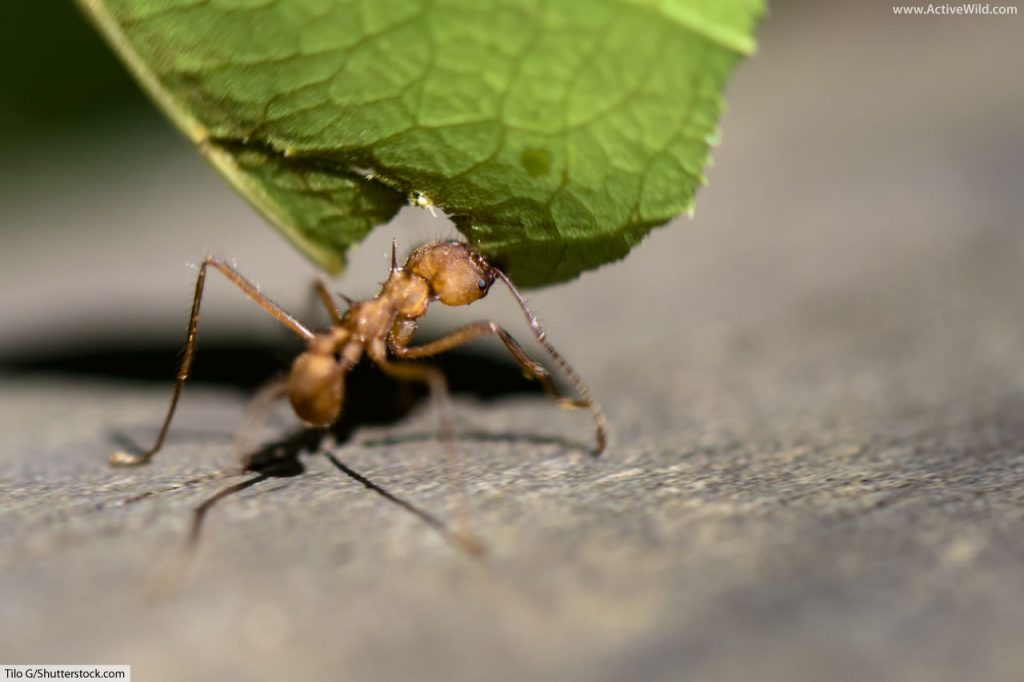
- Number of species: 47
- Genera: Atta / Acromyrmex
- Where found: Central & S America
They may exist small, but leafcutter ants are some of the most amazing – and of import – animals that alive in rainforests.
These industrious insects build nests that are upwards to 30 k (98 ft.) across. These huge nests are home to over 8 million insects!
(At that place are many countries in the world whose homo populations are smaller than the number of foliage cutter ants that alive in just one nest!)
Mayhap even more than amazingly, leafcutter ants grow their own food in special 'fungus gardens' within their immense nests!
Long trails of leafcutter ants tin oftentimes be seen carrying leaves from the rainforest canopy to their nest. The leaves are fed to the fungus, which in plow is fed to the ants' larvae.
- Y'all can find out more about leaf cutter ants on this page: Leafcutter Pismire Facts
Return to Index
Lemur
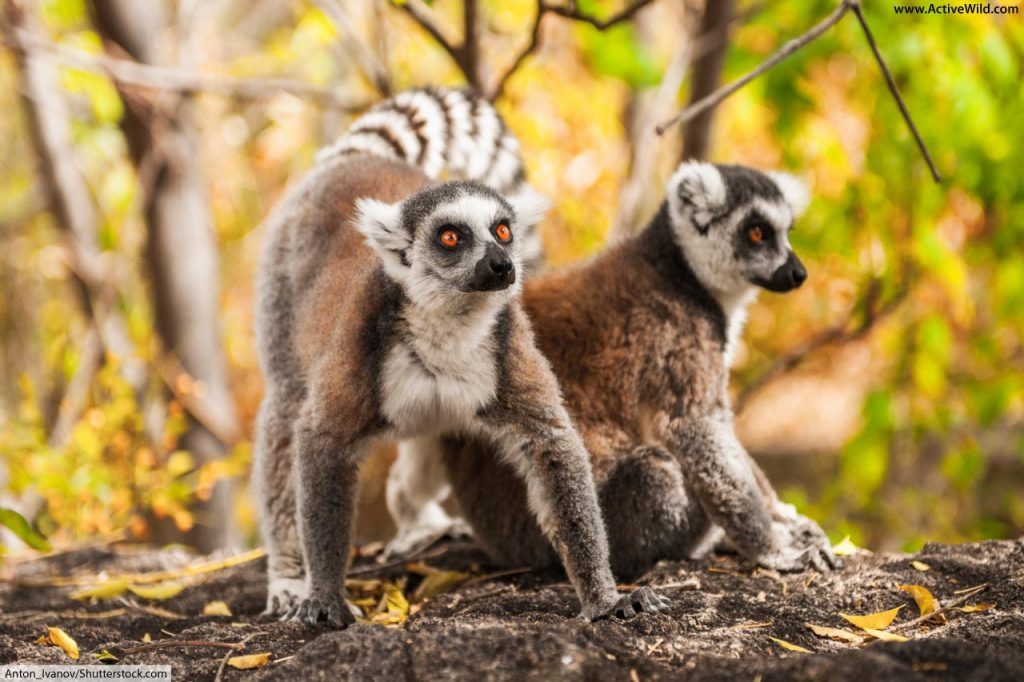
- Number of species: around 100
- Superfamily: Lemuroidea
- Where found: Africa (Republic of madagascar)
Lemurs are small primates establish in the rainforests of Madagascar. Lemurs are 'endemic' to Madagascar, which ways that they're found nowhere else on Earth!
There are around 100 species of lemur. The species shown in the photo above is a ring-tailed lemur. Sadly, similar many lemurs, the ring-tailed lemur is endangered.
- You can find out more about the band-tailed lemur on this folio: Band Tailed Lemur Facts
Return to Alphabetize
Leopard
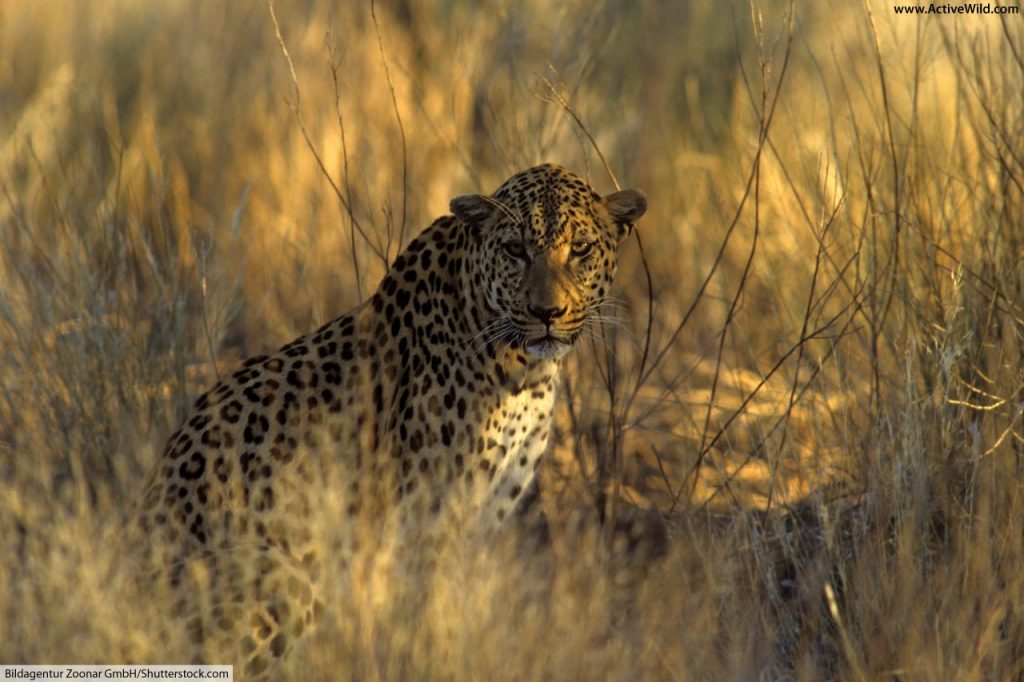
- Scientific name: Panthera pardus
- Conservation status: Vulnerable
- Where found: Africa & Asia
Leopards are big cats found in Africa and parts of Asia. The rainforest is just i habitat in which this versatile animal is able to live; it's as at home in savannas, woodlands and grasslands.
The spots on a leopard's coat are called 'rosettes'. One way of telling leopards and jaguars apart is by looking at their rosettes. A leopard's rosettes are empty, whereas those of a jaguar are filled with smaller black spots. Leopards are too slightly smaller than jaguars.
Leopards are incredibly stiff, and are known to conduct their casualty upward trees. (They have to do this, otherwise lions and hyenas might attempt to steal it from them!)
- Read more most leopards on this folio: Leopard Facts.
Return to Index
Lovely Fairywren
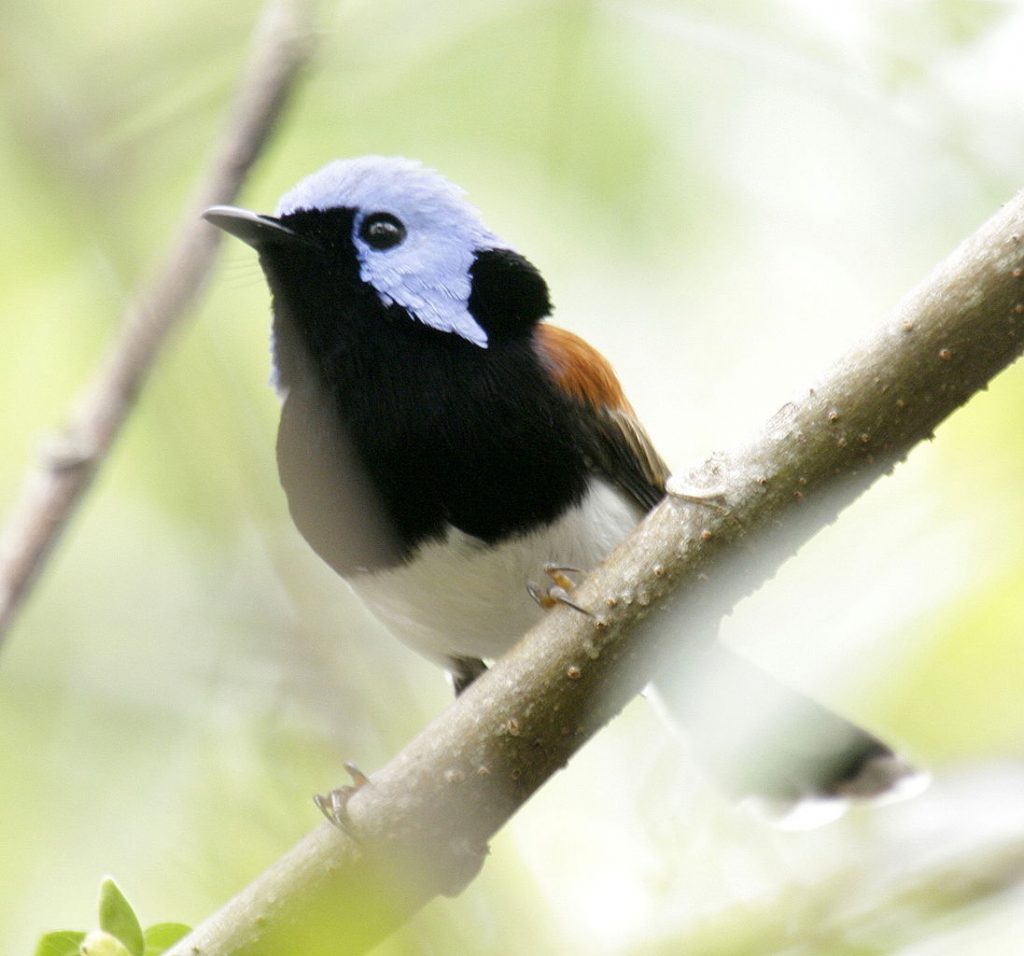
- Scientific name: Malurus amabilis
- Conservation status: Least Business
- Where plant: Australia
The lovely fairywren is an Australian rainforest bird found in the northeast of the country. Information technology oftentimes lives on the rainforest edge, and is oftentimes seen high in the rainforest awning. The species lives in minor family unit groups.
The lovely fairywren lives in the rainforests of northeastern Australia. Information technology is usually plant at the edges of rainforests, often high up in the rainforest canopy. The species lives in small family groups.
This colorful Australian bird is one of 11 species of fairywren, all of which are small and brightly-colored.
Return to Index
Macaw
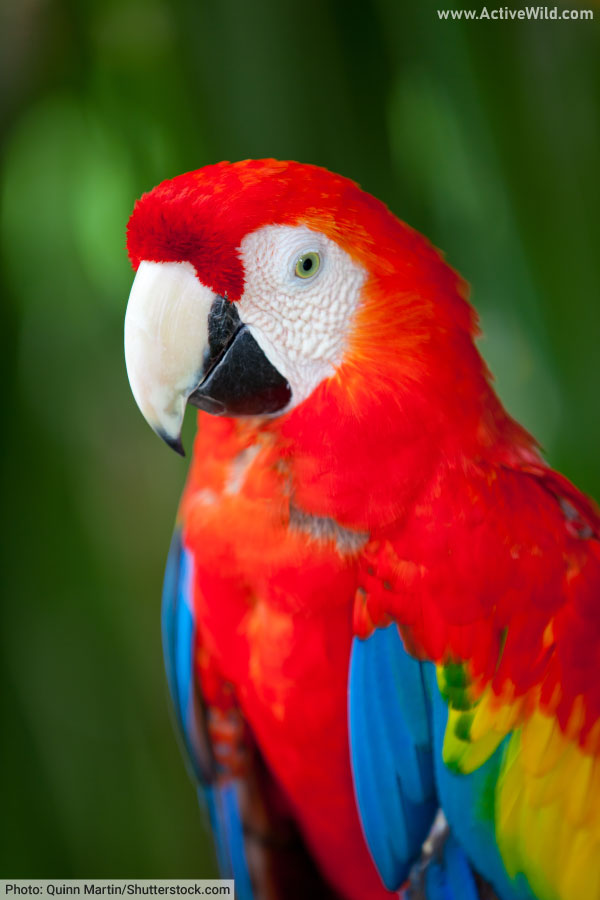
- Number of species: 19
- Family: Psittacidae
- Where found: The Americas
Macaws are members of the family unit Psittacidae, one of the three parrot families (not all of the members of this family are macaws). Macaws are big, colorful birds with large bills and long tails. Most species can be told apart from other parrots past their featherless faces.
In that location are 19 species of macaw. Several of these, including the hyacinth macaw, great green macaw and cerise macaw, are constitute in rainforests.
A macaw's anxiety are "zygodactyl"; the outer two toes face up forwards while the inner ii toes face up backwards. This helps the bird to climb and land on tree trunks. This type of foot is a characteristic of several woodland and forest birds, including parrots, woodpeckers and cuckoos.
Return to Index
Ocelot
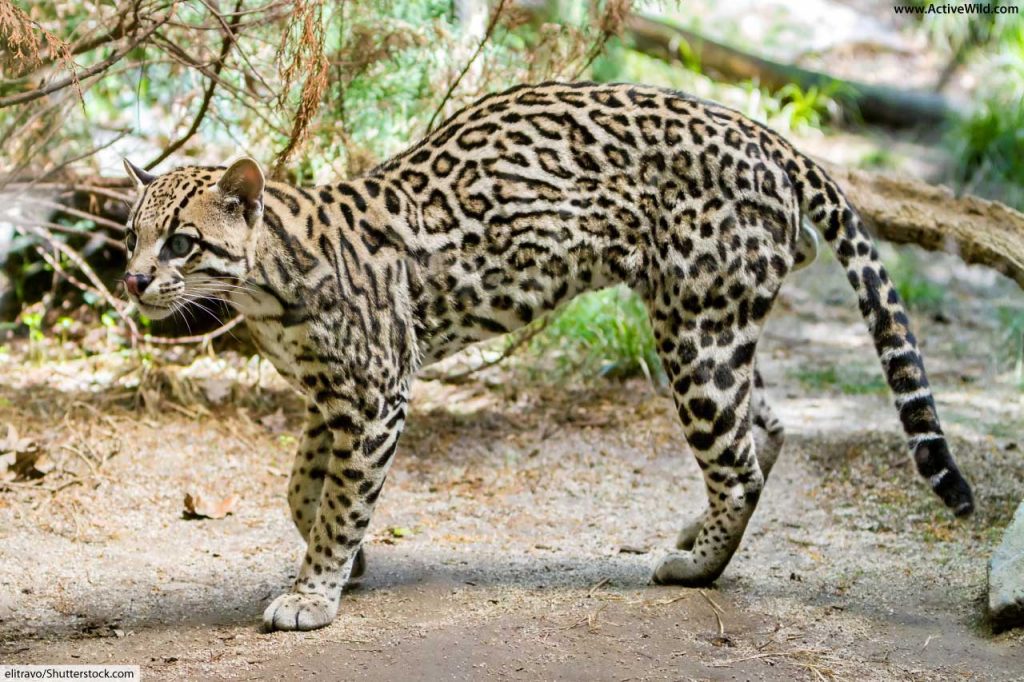
- Scientific name: Leopardus pardalis
- Conservation status: Least Concern
- Where found: Cardinal & South America
The ocelot is a small wild true cat found in South and Central America. The species is as well occasionally seen every bit far n as Texas and Arizona.
Around the size of a bobcat, the ocelot is sometimes referred to as the 'dwarf leopard' on behalf of its spotted coat.
The ocelot is a nocturnal predator that rarely targets prey larger than rabbits and armadillos.
- You tin can detect out more about the ocelot on this page: Ocelot Facts
Return to Alphabetize
Orangutan

- Number of species: 3
- Genus: Pongo
- Where found: Asia
Orangutans are members of the great ape family, Hominidae – only like us! Orangutans alive in rainforests on the Southeast Asian islands Borneo and Sumatra. The name 'orangutan' ways 'man of the woods' in Malay.
Orangutans are the world's largest arborial (tree-dwelling) animals. They spend up to 95% of their lives in the copse.
Sadly, all three species of orangutan are now critically endangered. This is mainly due to deforestation. Much of the orangutan'south natural habitat has been cleared to make way for palm oil plantations.
- Y'all can find out more about orangutans on this page: Orangutan Facts.
Return to Index
Piranha
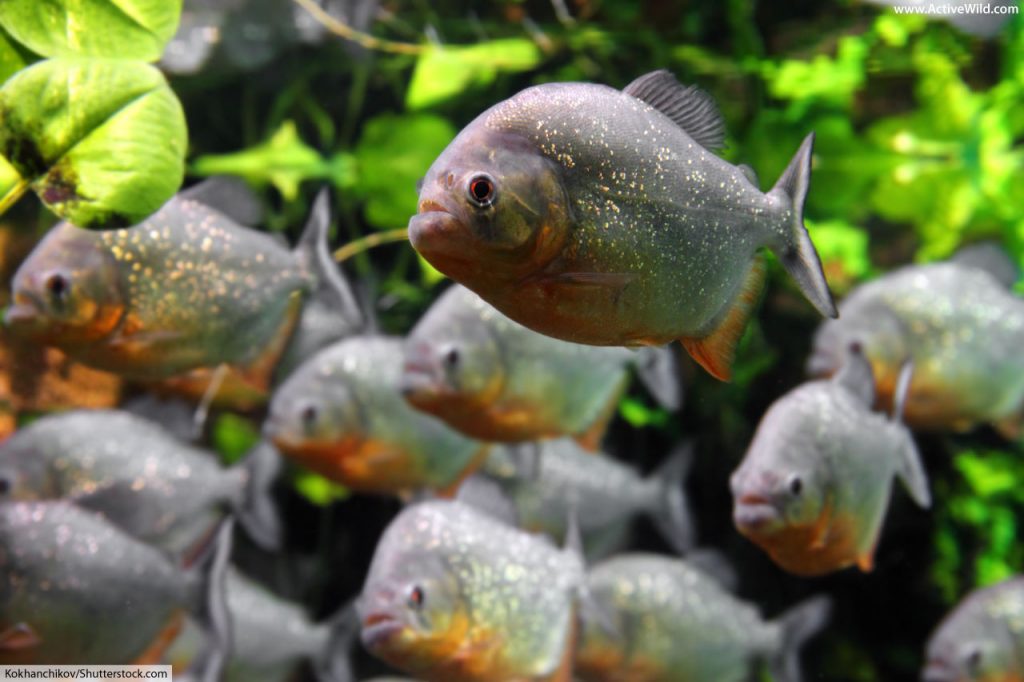
- Number of species: 30 to sixty+
- Subfamily: Serrasalminae (the subfamily also includes pacus and argent dollars)
- Where establish: Due south America
Piranhas are freshwater fish plant in the lakes and rivers of South America. With powerful jaws tightly packed with sharp teeth, piranhas have a reputation for being dangerous predators.
This fearsome reputation isn't entirely deserved. Piranhas aren't tiptop of the rainforest food chain, and are merely as likely to end upwardly every bit dinner for other animals.
Many piranhas, rather than being purely carnivorous, are actually omnivores who feed on found matter likewise as on meat.
Piranha attacks on humans are rare, and seldom upshot in serious injury.
There may be over 60 species of piranha (scientists are unsure of the exact number). The largest piranha species is the red-bellied piranha, which grows up to 50 cm (20 in) in length.
- You can find out more almost piranhas on this page: Piranha Facts.
Return to Index
Poisonous substance Dart Frog
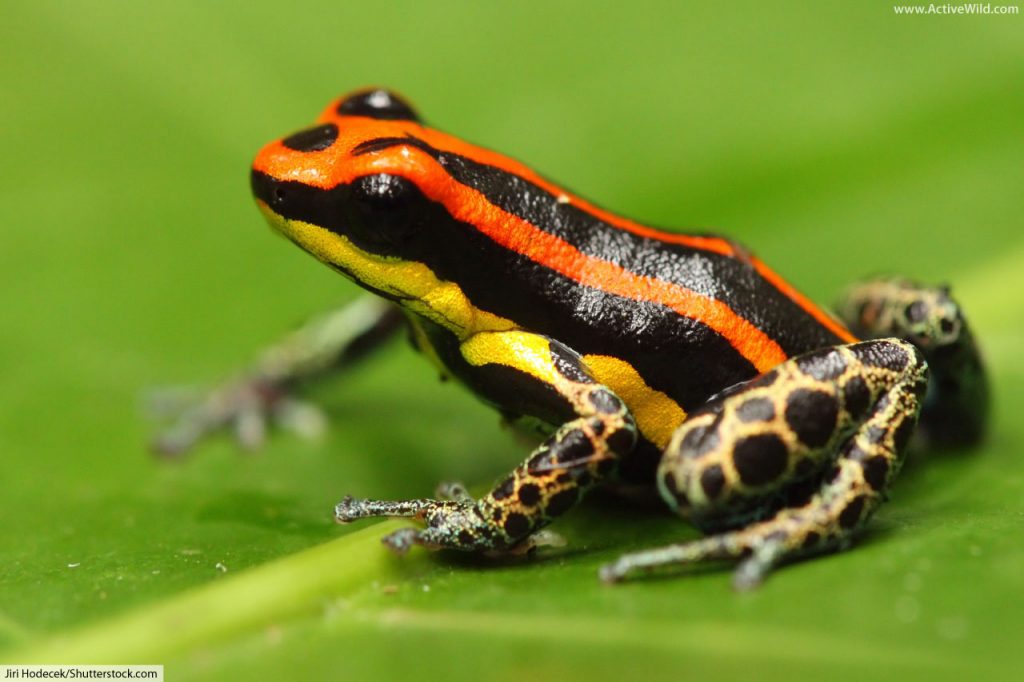
- Number of species: around 170
- Family: Dendrobatidae
- Where found: Central & South America
Most of the 170 or so species of poison dart frog have brightly-coloured skin. This acts as a warning to potential predators that the frogs are poisonous.
Hunters from rainforest tribes used poison taken from the skin of poison dart frogs on the tips of their blowdarts.
The golden poison frog (Phyllobates terribilis) is ane of the world'southward about poisonous animals.
Poisonous substance dart frogs are constitute in Primal and South American rainforests.
- You can find out more well-nigh poison dart frogs on this page: poison dart frog facts
Return to Alphabetize
Rainforest Scops Owl
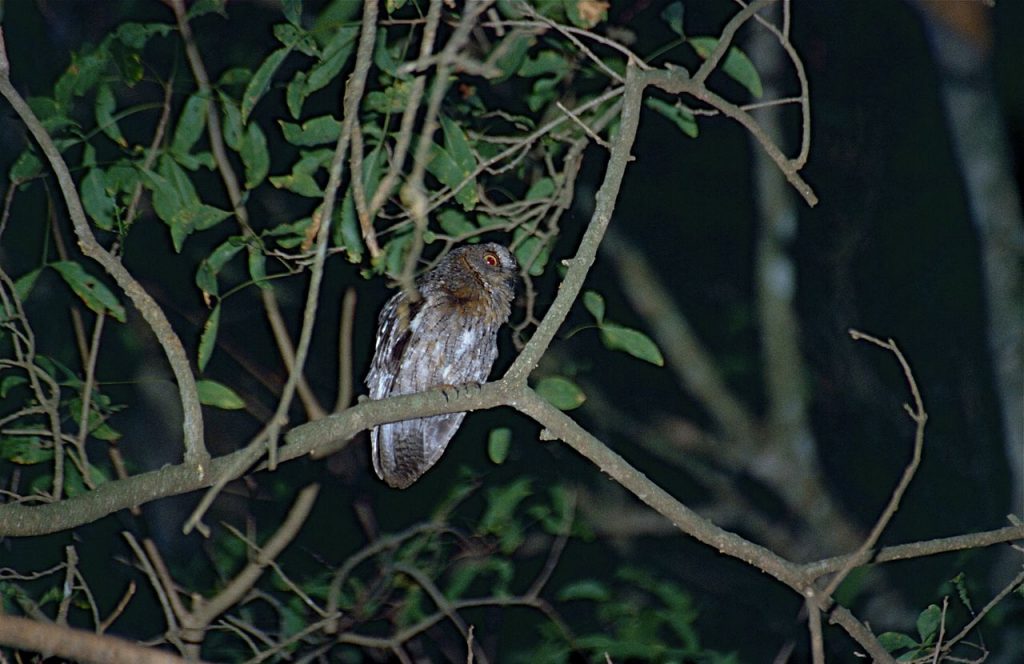
- Scientific name: Otus rutilus
- Conservation status: Least Business organization
- Where found: Africa (Madagascar)
This rainforest owl lives in the rainforests of eastern Madagascar. With a wingspan of up to 54 cm (21 in.), information technology is ane of the smaller owl species.
The rainforest scops owl appears in three color variations, brown, grey or scarlet-dark-brown. When threatened it raises the two ear-like crests on its head.
Return to Alphabetize
Scarlet Eyed Tree Frog
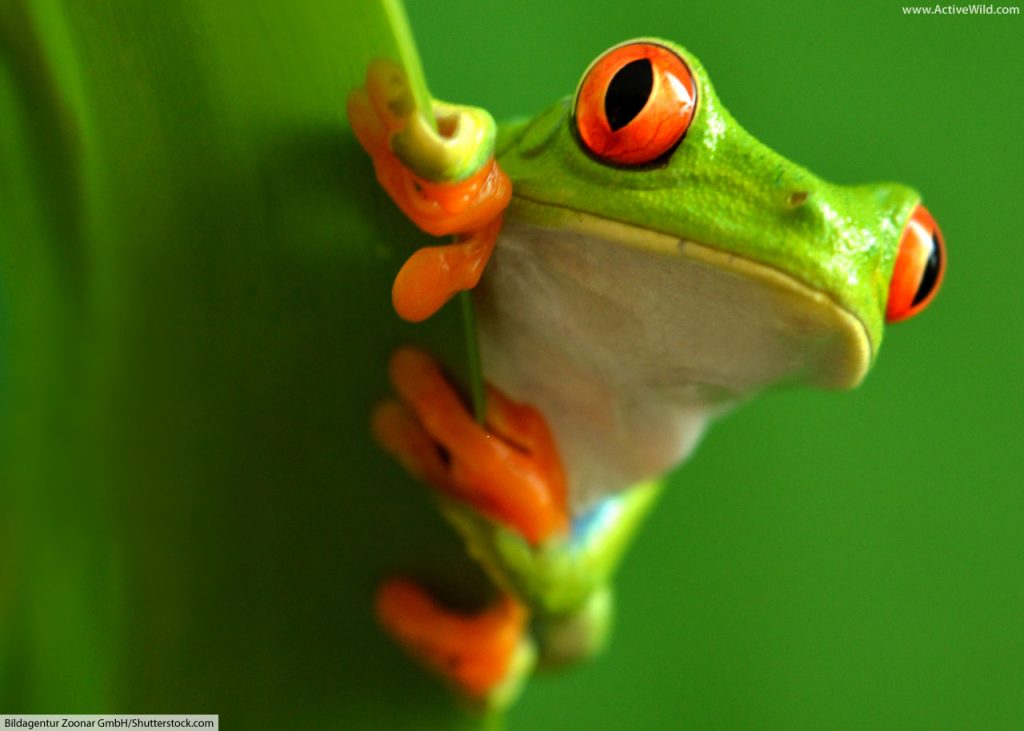
- Scientific proper noun: Agalychnis callidryas
- Conservation status: Least Business
- Where found: North & South America
Cheers to its eye-catching good looks the red-eyed tree frog has become one of the world'due south best-known amphibians.
When resting, the frog conceals its brilliant colors nether its green body and closes its large red eyes, making it surprisingly difficult to spot.
These iconic frogs live in the awning layer of Fundamental American rainforests.
The red eyed tree frog'southward brilliant colors are part of a defence mechanism chosen 'startle coloration'. The frog hopes that a quick flash of its vivid carmine eyes will momentarily confuse a potential predator, giving it time to escape!
- You tin can discover out more nigh the cherry-red eyed tree frog on this page: crimson-eyed tree frog facts.
Return to Index
Reddish Imported Burn down Pismire
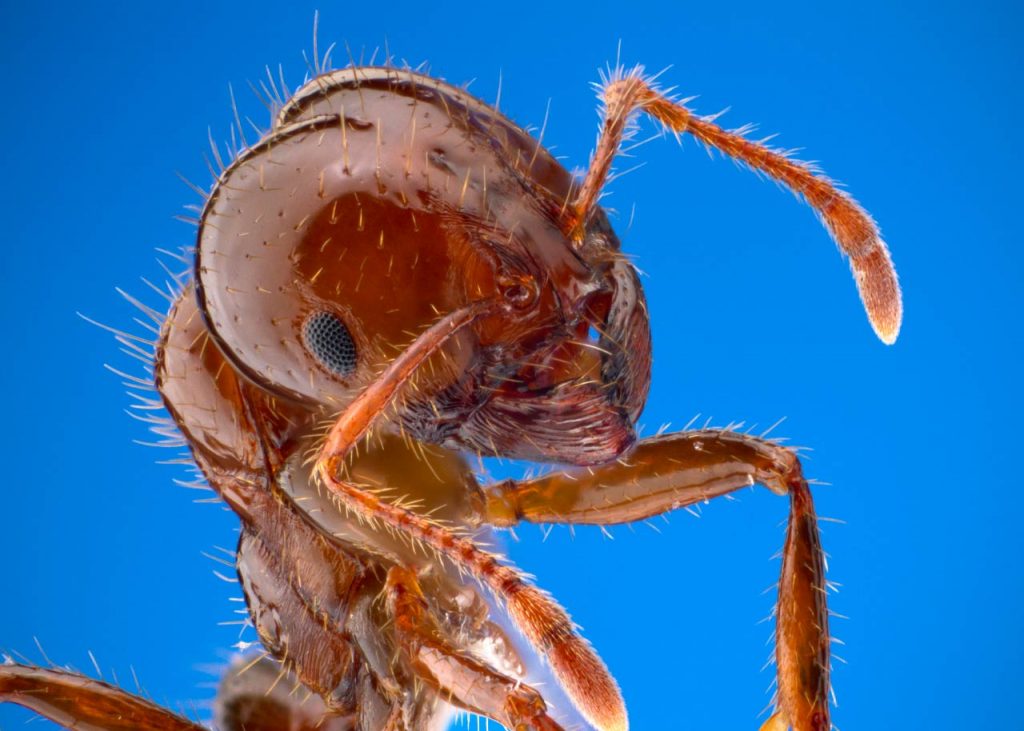
- Scientific name: Solenopsis invicta
- Conservation status: Unassessed
- Where plant: Southward America
The red imported burn down emmet is an ant in the genus Solenopsis. It is found in tropical areas of S America. The species is found in a number of habitats, including rainforests.
The species has spread beyond its original range, and is considered to be ane of the world's worst invasive species. It has been introduced to the Us and fifty-fifty to Australia via shipping containers.
Like all fire ants, the ruby-red imported fire ant tin deliver a painful sting. The species is resilient to floods and droughts, and has even been seen amassing into floating, living 'boats' consisting of thousands of individuals.
Render to Index
Sloth
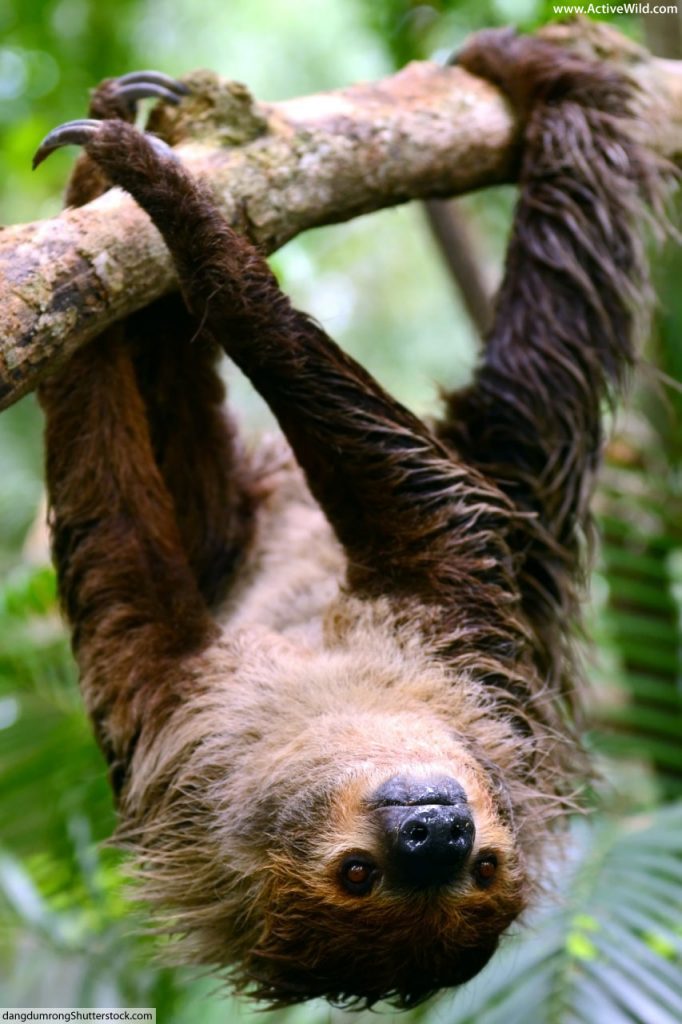
- Number of species: 6
- Suborder: Folivora
- Where found: Central & South America
Sloths are medium-sized rainforest mammals establish in South and Central America. These tree-dwelling animals spend virtually all of their lives hanging upside-down from branches in the rainforest canopy.
Sloths motion very slowly and accept a low metabolism (the charge per unit at which the body uses energy). This is an accommodation for living on leaves, which contain very little energy. Moving slowly also helps sloths stay hidden from predators such as the harpy hawkeye.
Because sloths are such slow movers, algae often begins to abound in their fur, giving them a green color. This is actually beneficial to the sloths, as it camouflages them amid the leaves.
- You tin can find out more virtually sloths on this folio: Sloth Facts
Return to Index
Southward American Lungfish
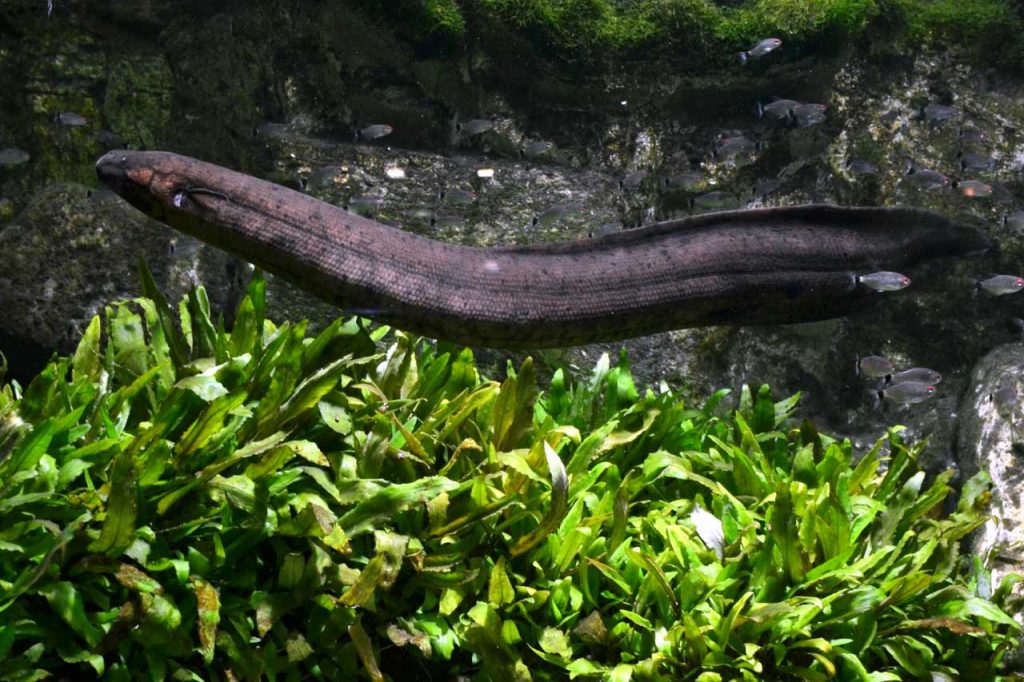
- Scientific name: Lepidosiren paradoxa
- Conservation condition: Unassessed
- Where found: South America
The S American lungfish is one of half dozen species of lungfish live today. Lungfish are fish that take retained their ancestors' power to exhale air. As the name suggests, lungfish have lungs, and tin breathe without using their gills.
The Due south American lungfish is plant in slow-moving rivers and streams in the Amazon Bowl. It is a long, thin fish that can grow to over 1 meter (3.3 ft.) in length.
During the dry out flavor, the Southward American lungfish is able to environment its torso in mucous and can survive buried in the mud, even if the river dries up.
Return to Index
Spider Monkey
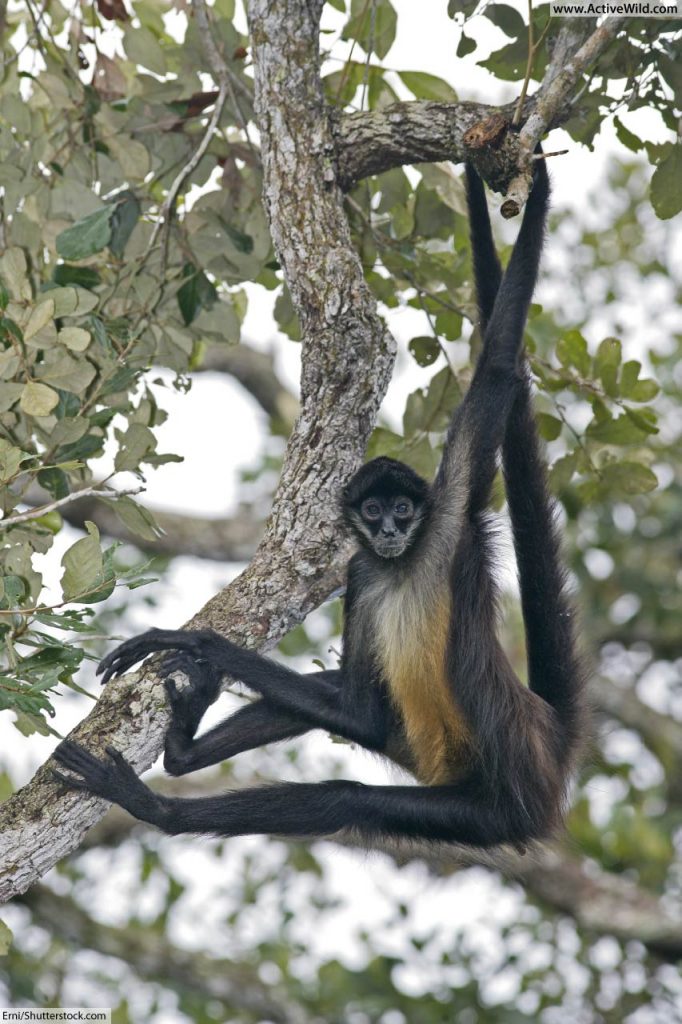
- Number of species: 7
- Genus: Ateles
- Where institute: South America
Spider monkeys get their name from their long limbs and tail; these agile primates actually look like giant spiders! Spider monkeys live in the rainforests of South America.
All seven species of Spider Monkey are at present threatened; ane is rated Vulnerable, 4 are Endangered, and ii are Critically Endangered.
- Y'all can detect out more about spider monkeys on this page: Spider Monkey Facts
Return to Index
Tapir
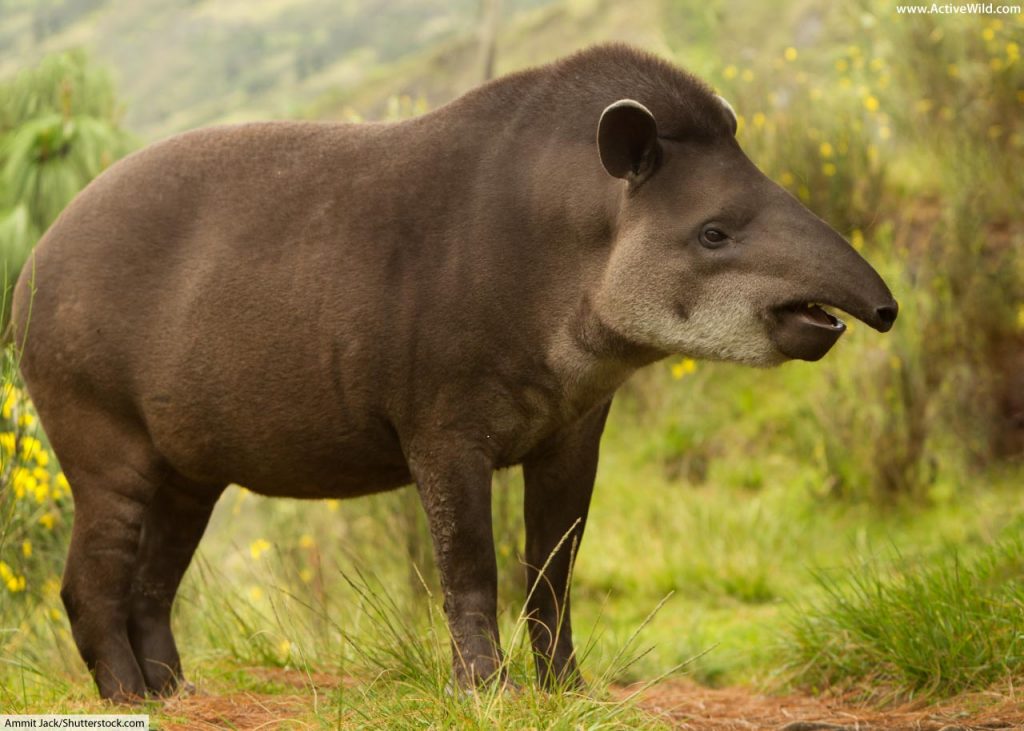
- Number of species: five
- Family: Tapiridae
- Where plant: Central & South America, Asia
Tapirs are big hoofed animals in the family Tapiridae. They have long, prehensile snouts which they use to grasp and manipulate foliage while foraging for food. (Prehensile means 'adapted for grasping or holding'.)
Tapiridae, the family unit to which all 5 species of tapir belong, is one of three animal families that make up the group of animals known every bit odd-toed ungulates.
The other families in this grouping are the horse family (Equidae) and the rhinoceros family unit (Rhinocerotidae).
The only species of tapir found outside of the Americas is the Malayan tapir, which is institute in Asia.
- You tin can notice out more about these rainforest animals on this page: Tapir Facts
Return to Index
Tarsier
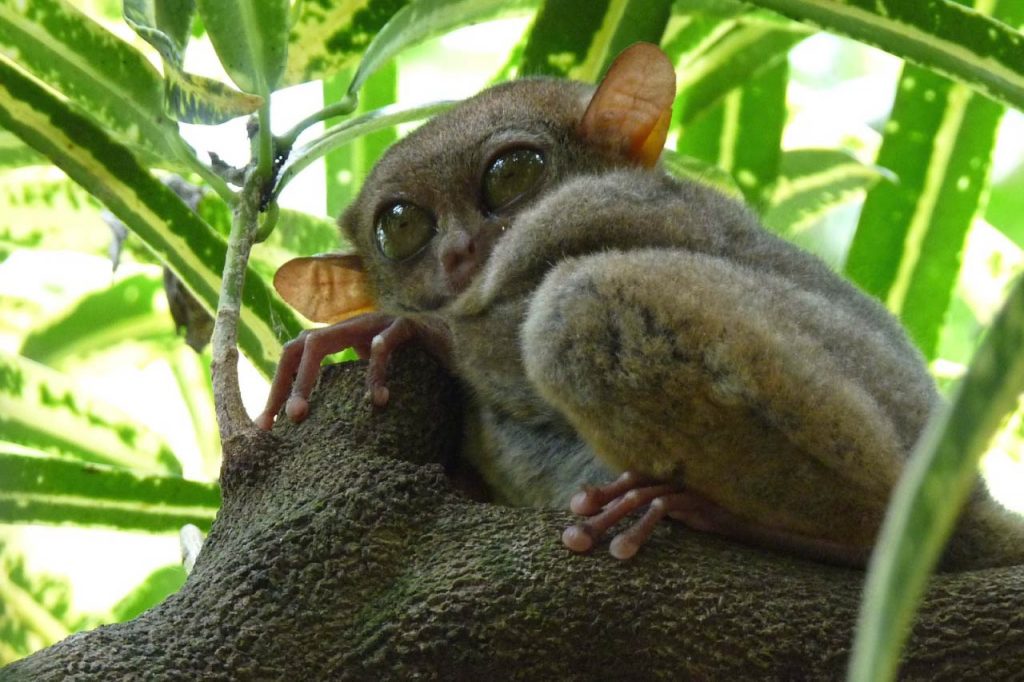
- Number of species: 11
- Family: Tarsiidae
- Where found: Asia
Tarsiers are small primates that alive in rainforests on Southeast Asian islands. They have extremely large eyes and long tails. (The optics of some tarsier species are larger than their brains!) Tarsiers are adapted for jumping, and move around past leaping through the trees.
These nocturnal animals exist mainly on a diet of insects.
There is some confusion over the exact number of tarsier species. Currently, eleven species of tarsier are listed in the Catalogue of Life (a listing of all of the world's species), but other government recognize more or fewer species. All tarsiers are in the family Tarsiidae.
- Yous can observe out more about tarsiers on this page: Tarsier Facts
Return to Index
Tiger

- Scientific proper name: Panthera tigris
- Conservation status: Endangered
- Where plant: Asia
The tiger is the world's largest cat species. It lives in a variety of habitats, including rainforests and a variety of other types of wood.
Tigers are found in several Asian countries, including India, Indonesia, Malaysia and Thailand. The species is also found in southeast Russia.
The tiger is an endangered species. It is estimated that in that location are only around 3,000 to 4,000 of these cute animals left in the wild. The main threats to tigers are habitat loss and poaching.
- You can notice out more most tigers on this folio: Tiger Facts.
Return to Index
Toucan

- Number of species: 43
- Family: Ramphastidae
- Where constitute: Primal and S America
Toucans are a family of around 43 crow-sized birds found in Central and South America.
These distinctive birds are known for their big, colorful bills.
A toucan uses its long bill to reach food without having to fly or climb to another branch. The nib also helps the toucan stay cool past transferring body heat to the surrounding air.
The keel-billed toucan, pictured above, lives in the canopy of Central American rainforests. It is primarily a frugivore (fruit-eater), although information technology will besides consume a variety of animals, including snakes and the nestlings of other birds.
- Y'all tin can discover out more near toucans on this page: Toucan Facts.
Return to Alphabetize
Vampire Bat
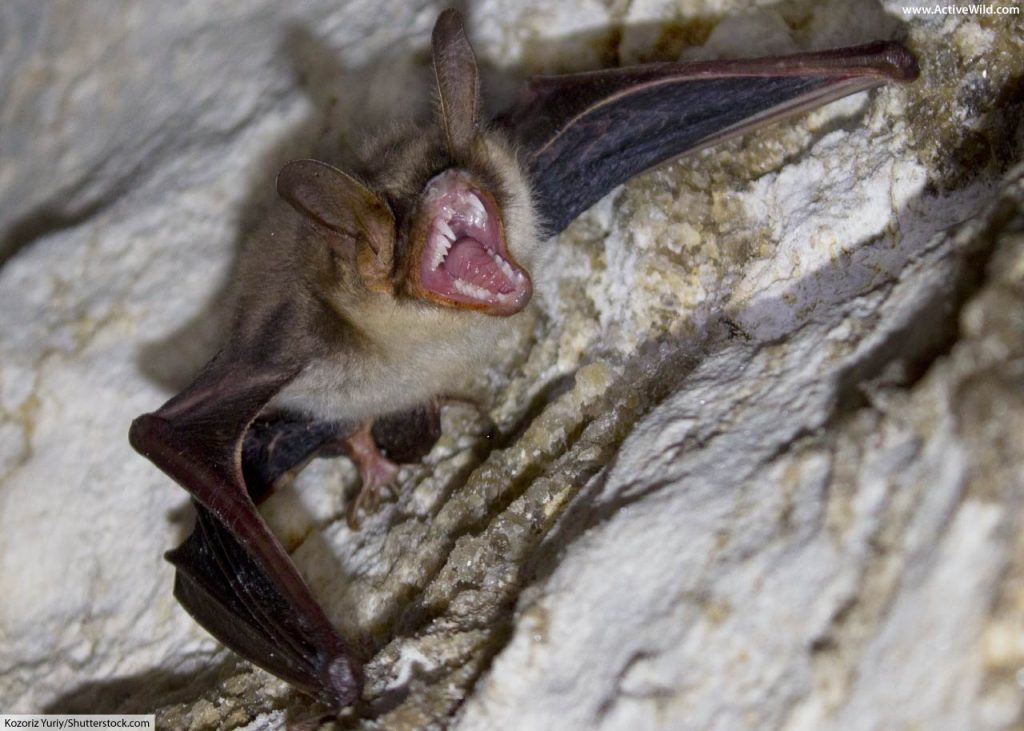
-
- Number of species: 3
- Subfamily: Desmodontinae
- Where found: North & Southward America
Bats are mammals whose arms have evolved into wings, allowing them to fly. There are 3 species of vampire bat: themutual vampire bat, the hairy-legged vampire bat, and the white-winged vampire bat.
All vampire bats feed on the blood of other animals. Vampire bats know exactly where to bite their victims by using infrared radiation to come across where the blood is flowing closest to the peel!
Vampire bats are constitute in the Americas. Also as beingness found in rainforests, they too live in woodlands and grasslands.
- You tin can find out more about vampire bats on this folio: Vampire Bat Facts
Render to Alphabetize
White-Lipped Treefrog
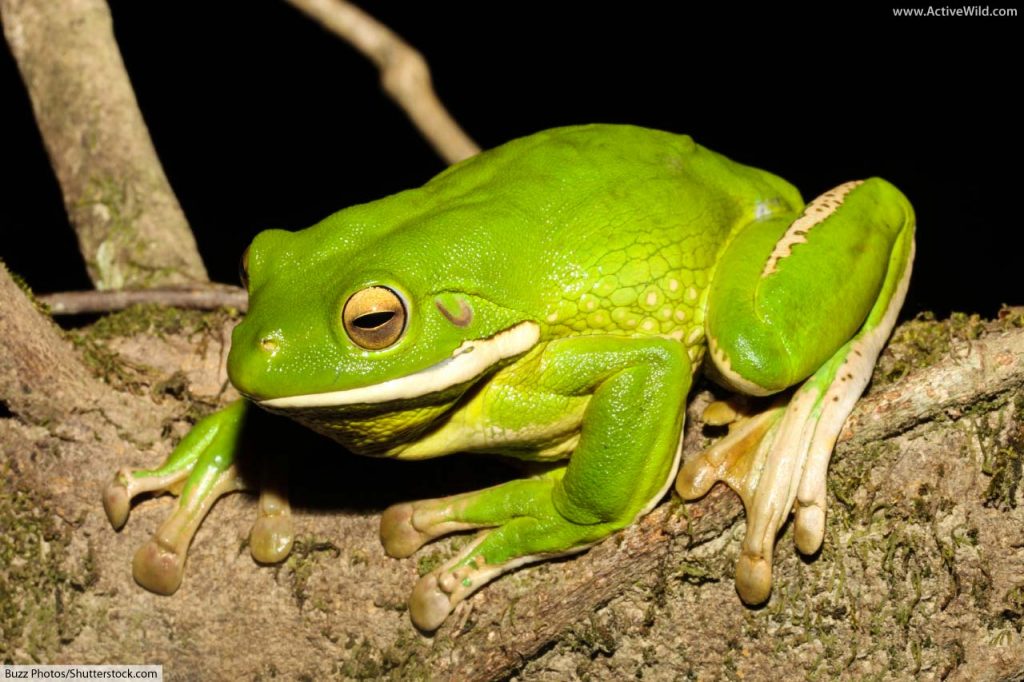
- Scientific name: Litoria infrafrenata
- Conservation status: To the lowest degree Concern
- Where found: Australia
This Australian amphibian is the world's largest species of tree frog, and Commonwealth of australia's largest native frog. The species is also found in Papua New Guinea.
Tree frogs are amphibians in the family unit Hylidae. Tree frogs are named for their arboreal (tree-abode) lifestyle.
The white-lipped tree frog is found in n-eastward Queensland, and is present in the Daintree Rainforest. The species is besides found in urban areas, and occasionally gets transported hundreds of miles to other states in assistant boxes.
You can notice out more nigh the white-lipped tree frog on this folio: White-Lipped Tree Frog Facts
Return to Index
What Is A Rainforest?
As the name suggests, rainforests are forests constitute in areas that receive a loftier amount of rain. All rainforests receive at least 1.8 m (70 in.) of rain in a year; some rainforests receive over three m (118 in.).
Tropical rainforests are rainforests that are located near the Equator. They are hot, humid places. The average monthly temperature in a tropical rainforest is at to the lowest degree 18 °C (64 °F), with little departure betwixt summer and winter.
- You can observe out near the other types of rainforest here: Rainforest Facts
A tropical rainforest's unique mix of loftier rainfall and constant high temperature provides plants and animals with an ideal environment in which to live.
Because of their high biodiversity, tropical rainforests are among the earth'south nigh important habitats. (Biodiversity is the amount of different species that alive in one expanse.)
Rainforest Animals List: Observe More with Active Wild!
Nosotros hope that you've enjoyed discovering the amazing rainforest animals on this page. Rainforests are dwelling house to a wide and varied range of species and this aboriginal habitat is vitally important for sustaining a large proportion of the world'southward biodiversity.
What's your favorite rainforest animate being? Are there whatever animals we've missed? Let us know in the comments below!
The animals on this list represent only a fraction of the species that live in the earth'due south rainforests; you can discover more animals on the pages listed below:
- Rainforest Mammals List with Pictures & Facts
- Rainforest Reptiles Listing with Pictures & Facts
- Rainforest Insects List with Pictures & Facts
- Rainforest Monkeys List with Pictures & Facts
You tin can observe out more nearly rainforests on the following pages:
- Download Active Wild Rainforest Workbooks
- Find out more virtually the world's rainforests at our main Rainforests Page
- Interested in the Amazon Rainforest in item? You lot'll find pictures and facts about its animals and plants here: What is in the Amazon Rainforest?
- Rainforest plants are but as exciting equally rainforest animals! Detect out why here: Rainforest Plants List
- Discover the layers of a rainforest: Rainforest Layers
- Observe out more about the animate being kingdom here: Animals: The Ultimate Guide
- Non all of the world'southward rainforests are in tropical regions. You lot can detect out well-nigh temperate rainforests on this page: Temperate Rainforest Facts
Source: https://www.activewild.com/rainforest-animals-list/
Posted by: castillejaevembee1956.blogspot.com

0 Response to "What Animals Can Be Found In The Tropical Rainforest"
Post a Comment